Aberdeen: Difference between revisions
| (5 intermediate revisions by 3 users not shown) | |||
| Line 17: | Line 17: | ||
|website=[http://www.aberdeencity.gov.uk/ aberdeencity.gov.uk] | |website=[http://www.aberdeencity.gov.uk/ aberdeencity.gov.uk] | ||
}} | }} | ||
'''Aberdeen''' is Scotland's third most populous city | '''Aberdeen''' is the [[county town]] of [[Aberdeenshire]] and Scotland's third most populous city. It is a major centre of the North Sea oil industry. | ||
The city's nicknames include the ''Granite City'', the ''Grey City'' and the ''Silver City with the Golden Sands''. During the mid-18th to mid-20th centuries, Aberdeen's buildings incorporated locally quarried grey granite, whose mica deposits sparkle like silver.<ref name="agtb">{{cite web|url=http://www.agtb.org/aberdeen-scotland.htm|publisher=Aberdeen and Grampian Tourist Board|title=The Granite City|accessdate=2007-02-08}}</ref> The city has a long, sandy coastline. Since the discovery of North Sea oil in the 1970s, other nicknames have been the ''Oil Capital of Europe'' or the ''Energy Capital of Europe''.<ref name="uni-abdn">{{cite web |url=http://www.abdn.ac.uk/central/abdn/|title=About Aberdeen|publisher=University of Aberdeen |accessdate=2007-02-08}}</ref> | The city's nicknames include the ''Granite City'', the ''Grey City'' and the ''Silver City with the Golden Sands''. During the mid-18th to mid-20th centuries, Aberdeen's buildings incorporated locally quarried grey granite, whose mica deposits sparkle like silver.<ref name="agtb">{{cite web|url=http://www.agtb.org/aberdeen-scotland.htm|publisher=Aberdeen and Grampian Tourist Board|title=The Granite City|accessdate=2007-02-08}}</ref> The city has a long, sandy coastline. Since the discovery of North Sea oil in the 1970s, other nicknames have been the ''Oil Capital of Europe'' or the ''Energy Capital of Europe''.<ref name="uni-abdn">{{cite web |url=http://www.abdn.ac.uk/central/abdn/|title=About Aberdeen|publisher=University of Aberdeen |accessdate=2007-02-08}}</ref> | ||
In 1319, Aberdeen received Royal Burgh status from | In 1319, Aberdeen received Royal Burgh status from Robert the Bruce, transforming the city economically. The city has two universities, the University of Aberdeen was founded in 1495, which makes it one of the oldest in Britain. The Robert Gordon University was awarded university status in 1992 too. The traditional industries of fishing, paper-making, shipbuilding, and textiles have been overtaken by the oil industry and Aberdeen's seaport. In consequence, Aberdeen has become a major world centre for engineering expertise. | ||
Aberdeen Heliport, supporting the offshore oil rigs, is one of the busiest commercial heliports in the world<ref name="BAA">{{cite web |url=http://www.aberdeenairport.com/portal/site/default/menuitem.25db388ed11fced74aafa810c02865a0|title=BAA Aberdeen Airport|accessdate=2007-07-31}}</ref> and the seaport is the largest in the north-east of Scotland.<ref name="seaport">{{cite web |url=http://uk.archiseek.com/scotland/aberdeen/index.html|archiveurl=http://web.archive.org/web/20070609221650/http://uk.archiseek.com/scotland/aberdeen/index.html|archivedate=2007-06-09 |title=Architecture of Aberdeen, Scotland|accessdate=2007-05-23}}</ref> | Aberdeen Heliport, supporting the offshore oil rigs, is one of the busiest commercial heliports in the world<ref name="BAA">{{cite web |url=http://www.aberdeenairport.com/portal/site/default/menuitem.25db388ed11fced74aafa810c02865a0|title=BAA Aberdeen Airport|accessdate=2007-07-31}}</ref> and the seaport is the largest in the north-east of Scotland.<ref name="seaport">{{cite web |url=http://uk.archiseek.com/scotland/aberdeen/index.html|archiveurl=http://web.archive.org/web/20070609221650/http://uk.archiseek.com/scotland/aberdeen/index.html|archivedate=2007-06-09 |title=Architecture of Aberdeen, Scotland|accessdate=2007-05-23}}</ref> | ||
| Line 31: | Line 31: | ||
[[File:Aberdeen1.jpg|thumb|left|The Castlegate and Union Street (c.1900)]] | [[File:Aberdeen1.jpg|thumb|left|The Castlegate and Union Street (c.1900)]] | ||
The area around Aberdeen has been settled since at least 8,000 years ago,<ref name="prehistory">{{cite web url=http://www.scottishaccommodationindex.com/aberdeenpics.htm|title=Welcome to Aberdeen | The area around Aberdeen has been settled since at least 8,000 years ago,<ref name="prehistory">{{cite web|url=http://www.scottishaccommodationindex.com/aberdeenpics.htm|title=Welcome to Aberdeen | ||
|publisher=Aberdeen Accommodation Index|accessdate=2007-02-19}}</ref> when prehistoric villages lay around the mouths of the rivers [[River Dee, Aberdeenshire|Dee]] and [[River Don, Aberdeenshire|Don]]. | |publisher=Aberdeen Accommodation Index|accessdate=2007-02-19}}</ref> when prehistoric villages lay around the mouths of the rivers [[River Dee, Aberdeenshire|Dee]] and [[River Don, Aberdeenshire|Don]]. | ||
The city began as two separate burghs: [[Old Aberdeen]] at the mouth of the river Don; and New Aberdeen, a fishing and trading settlement, where the Denburn waterway entered the river Dee estuary. The earliest charter was granted by | The city began as two separate burghs: [[Old Aberdeen]] at the mouth of the river Don; and New Aberdeen, a fishing and trading settlement, where the Denburn waterway entered the river Dee estuary. The earliest charter was granted by William I in 1179 and confirmed the corporate rights granted by David I. | ||
In 1319, the Great Charter of | In 1319, the Great Charter of Robert the Bruce transformed Aberdeen into a property-owning and financially independent community. Granted with it was the nearby [[Forest of Stocket]], whose income formed the basis for the city's Common Good Fund, which still benefits Aberdonians.<ref name="keith">{{cite book|author=Keith, Alexander|year=1987|title=A Thousand Years of Aberdeen |publisher=Aberdeen University Press}}</ref><ref name="fraser">{{cite book |first=W. Hamish|last=Fraser|title=Aberdeen, 1800 to 2000: A New History |year=2000 |publisher=Tuckwell Press |location=Edinburgh}}</ref> | ||
During the Wars of Scottish Independence, Aberdeen was under English rule, so Robert the Bruce laid siege to Aberdeen Castle before destroying it in 1308 followed by the massacring of the English garrison and the retaking of Aberdeen. The city was burned by | During the Wars of Scottish Independence, Aberdeen was under English rule, so Robert the Bruce laid siege to Aberdeen Castle before destroying it in 1308 followed by the massacring of the English garrison and the retaking of Aberdeen. The city was burned by King Edward III of England in 1336, but was rebuilt and extended, and called New Aberdeen. The city was strongly fortified to prevent attacks by neighbouring lords, but the gates were removed by 1770. | ||
During the Wars of the Three Kingdoms of 1644-1647, the city was impartially plundered by both sides. In 1644, it was taken and ransacked by Royalist troops after the Battle of Aberdeen.<ref>{{cite book |first=Chris |last=Brown |title=The Battle of Aberdeen 1644|year=2002|publisher=Tempus Publishing |location=Stroud, Gloucestershire}}</ref> In 1647 an outbreak of bubonic plague killed a quarter of the population. | During the Wars of the Three Kingdoms of 1644-1647, the city was impartially plundered by both sides. In 1644, it was taken and ransacked by Royalist troops after the Battle of Aberdeen.<ref>{{cite book |first=Chris |last=Brown |title=The Battle of Aberdeen 1644|year=2002|publisher=Tempus Publishing |location=Stroud, Gloucestershire}}</ref> In 1647 an outbreak of bubonic plague killed a quarter of the population. | ||
| Line 44: | Line 44: | ||
In the eighteenth century, a new Town Hall was built and the first social services appeared with the Aberdeen Royal Infirmary at Woolmanhill in 1742 and the Lunatic Asylum in 1779. The council began major road improvements at the end of the century with the main thoroughfares of George Street, King Street and Union Street all completed at the start of the next century. | In the eighteenth century, a new Town Hall was built and the first social services appeared with the Aberdeen Royal Infirmary at Woolmanhill in 1742 and the Lunatic Asylum in 1779. The council began major road improvements at the end of the century with the main thoroughfares of George Street, King Street and Union Street all completed at the start of the next century. | ||
A century later, the increasing economic importance of Aberdeen and the development of the shipbuilding and fishing industries led to the existing harbour with Victoria Dock, the South Breakwater, and the extension to the North Pier. The expensive infrastructure | A century later, the increasing economic importance of Aberdeen and the development of the shipbuilding and fishing industries led to the existing harbour with Victoria Dock, the South Breakwater, and the extension to the North Pier. The expensive infrastructure programme had repercussions, and in 1817 the city was bankrupt. However, a recovery was made in the general prosperity which followed the Napoleonic Wars. Gas street lighting arrived in 1824 and an enhanced water supply appeared in 1830 when water was pumped from the Dee to a reservoir in Union Place. An underground sewer system replaced open sewers in 1865.<ref name="fraser" /> | ||
The city was first incorporated in 1891. Although Old Aberdeen still has a separate charter and history, it and New Aberdeen are no longer truly distinct, the city | The city was first incorporated in 1891. Although Old Aberdeen still has a separate charter and history, it and New Aberdeen are no longer truly distinct, the city having expanded to incorporate both towns and neighbouring suburbs, including the Royal Burgh of [[Torry]] to the south of the River Dee in [[Kincardineshire]]. | ||
===Names of the City=== | ===Names of the City=== | ||
[[Old Aberdeen]] is the approximate location of ''Aberdon'' the first settlement of Aberdeen; this literally means "the mouth of the Don" in relation to the local river. The modern name Aberdeen literally means between the Dee (the other local river) and Don. The prefix; ''Aber-'' means "mouth" or "confluence" in relation to the rivers.<ref name="Charnock">{{cite book|first=Richard Stephen |last=Charnock|title=Local Etymology: A Derivative Dictionary of Geographical Names|published=1859|publisher=Houlston and Wright}}</ref> | [[Old Aberdeen]] is the approximate location of ''Aberdon'' the first settlement of Aberdeen; this literally means "the mouth of the Don" in relation to the local river. The modern name Aberdeen literally means between the Dee (the other local river) and Don. The prefix; ''Aber-'' means "mouth" or "confluence" in relation to the rivers.<ref name="Charnock">{{cite book|first=Richard Stephen |last=Charnock|title=Local Etymology: A Derivative Dictionary of Geographical Names|published=1859|publisher=Houlston and Wright}}</ref> | ||
Gaelic scholars believe the name came from the prefix ''Aber-'' and ''da-aevi'' (variation;''Da-abhuin'', ''Da-awin'') - which means "the mouth of two rivers". In Gaelic the name is ''Obar Dheathain'' (variation; ''Obairreadhain'') and in Latin, the Romans referred to it as ''Devana''. Mediæval (or ecclesiastical) Latin has it as ''Aberdonia''. | |||
==Geography== | ==Geography== | ||
On the coast, Aberdeen has a long sand beach between the two rivers, the [[River Dee, Aberdeenshire|Dee]] and the [[River Don, Aberdeenshire|Don]], which turns into high sand dunes north of the Don stretching as far as [[Fraserburgh]]. To the south of the Dee are steep rocky cliff faces with only minor pebble and shingle beaches in deep inlets. A number of granite outcrops along the south coast have been quarried in the past, making for spectacular scenery and good rock-climbing. | On the coast, Aberdeen has a long sand beach between the two rivers, the [[River Dee, Aberdeenshire|Dee]] and the [[River Don, Aberdeenshire|Don]], which turns into high sand dunes north of the Don stretching as far as [[Fraserburgh]]. To the south of the Dee are steep rocky cliff faces with only minor pebble and shingle beaches in deep inlets. A number of granite outcrops along the south coast have been quarried in the past, making for spectacular scenery and good rock-climbing. | ||
The modern city's urban area extends to include the former burghs of [[Old Aberdeen]], New Aberdeen, | The modern city's urban area extends to include the former burghs of [[Old Aberdeen]], New Aberdeen, Woodside and the Royal Burgh of [[Torry]] to the south of [[River Dee, Aberdeenshire|River Dee]] in [[Kincardineshire]]. The city is built on many hills, with the original beginnings of the city growing from Castle Hill, St Catherine's Hill and Windmill Hill.<ref>{{cite web|url=http://www.geo.ed.ac.uk/scotgaz/councils/councilfirst1.html|title=Aberdeen City |publisher=The Gazetteer for Scotland|accessdate=2007-02-20}}</ref> | ||
===Climate=== | ===Climate=== | ||
| Line 65: | Line 63: | ||
During the winter, especially throughout December, the length of the day is very short, averaging 6 hours and 40 minutes between sunrise and sunset at the Winter Solstice. As winter progresses, the length of the day grows fairly quickly, to 8 hours and 20 minutes by the end of January. As summer begins, the days will be around 18 hours long, having 17 hours and 57 minutes between sunrise and sunset, with Nautical Twilight lasting the entire night. Temperatures at this time of year will be around 17 °C during the day. | During the winter, especially throughout December, the length of the day is very short, averaging 6 hours and 40 minutes between sunrise and sunset at the Winter Solstice. As winter progresses, the length of the day grows fairly quickly, to 8 hours and 20 minutes by the end of January. As summer begins, the days will be around 18 hours long, having 17 hours and 57 minutes between sunrise and sunset, with Nautical Twilight lasting the entire night. Temperatures at this time of year will be around 17 °C during the day. | ||
== | ==People== | ||
[[File:AberdeenDemographic.gif|right|thumb|Aberdeen demographics<ref>{{cite web|url=http://www.visionofbritain.org.uk|title=Data Documentation|accessdate=2007-05-15}}</ref>]] | [[File:AberdeenDemographic.gif|right|thumb|Aberdeen demographics<ref>{{cite web|url=http://www.visionofbritain.org.uk|title=Data Documentation|accessdate=2007-05-15}}</ref>]] | ||
In 1396 the population was about 3,000. By 1801 it had become 26,992; (1901) 153,503; (1941) 182,467.<ref>{{cite web|url=http://web.archive.org/web/20080120201443/http://www.visionofbritain.org.uk/data_cube_table_page.jsp?data_theme=T_POP&data_cube=N_TPop&u_id=10192985&c_id=10090283&add=N|title=Aberdeen Population|accessdate=2007-02-19}}</ref> In 2001 the UK | In 1396 the population was about 3,000. By 1801 it had become 26,992; (1901) 153,503; (1941) 182,467.<ref>{{cite web|url=http://web.archive.org/web/20080120201443/http://www.visionofbritain.org.uk/data_cube_table_page.jsp?data_theme=T_POP&data_cube=N_TPop&u_id=10192985&c_id=10090283&add=N|title=Aberdeen Population|accessdate=2007-02-19}}</ref> In 2001 the UK census records the Aberdeen City Council area's population at 212,125,<ref name="councilpop">{{cite web|url=http://www.scrol.gov.uk/scrol/browser/profile.jsp?profile=Population&mainArea=Aberdeen+City&mainLevel=CouncilArea|title=Comparative Population Profile: Aberdeen City Council Area, Scotland|accessdate=2007-02-21}}</ref> but the Aberdeen locality's population at 184,788.<ref>{{cite web|url=http://www.scrol.gov.uk/scrol/browser/profile.jsp?profile=Population&mainArea=Aberdeen&mainLevel=Locality|title=Comparative Population Profile: Aberdeen Locality, Scotland|accessdate=2007-02-21}}</ref> Data from the Aberdeen specific locality of the 2001 UK census shows that the demographics include a median male age of 35 and female age of 38, which are younger than Scotland's average and a 49% to 51% male-to-female ratio.<ref name="councilpop" /> | ||
The census showed that there are fewer young people in Aberdeen, with 16.4% under 16, opposed to the national average of 19.2%.<ref name="citycensusreview" /> Ethnically, 15.7% were born outside of Scotland, higher than the national average of 12.9%. Of this population 8.4% were born in England.<ref name="citycensusreview" /> 3% of Aberdonians stated to be from an ethnic minority (non-white) in the 2001 census, with 0.7% from the Indian-subcontinent and 0.6% Asian; in comparison, Scotland's overall population of non-white origin is 2%. This is a lower percentage than any of Scotland's other three main cities, [[Glasgow]], [[Edinburgh]], and [[Dundee]].<ref name="citycensusreview" /> The most multicultural part of the city is George Street, which has many ethnic restaurants, supermarkets and hairdressers. | The census showed that there are fewer young people in Aberdeen, with 16.4% under 16, opposed to the national average of 19.2%.<ref name="citycensusreview" /> Ethnically, 15.7% were born outside of Scotland, higher than the national average of 12.9%. Of this population 8.4% were born in England.<ref name="citycensusreview" /> 3% of Aberdonians stated to be from an ethnic minority (non-white) in the 2001 census, with 0.7% from the Indian-subcontinent and 0.6% Asian; in comparison, Scotland's overall population of non-white origin is 2%. This is a lower percentage than any of Scotland's other three main cities, [[Glasgow]], [[Edinburgh]], and [[Dundee]].<ref name="citycensusreview" /> The most multicultural part of the city is George Street, which has many ethnic restaurants, supermarkets and hairdressers. | ||
| Line 75: | Line 73: | ||
The median income of a household in the city is £16,813 (the mean income is £20,292)<ref>{{cite web|url=http://web.archive.org/web/20070927031848/http://www.aberdeencity.gov.uk/ACCI/nmsruntime/saveasdialog.asp?lID=1726&sID=332|title=Low Income Households in Aberdeen|author=Aberdeen City Council|accessdate=2007-03-12}}</ref> (2005) which places approximately 18% households in the city below the poverty line (defined as 60% of the mean income). Conversely, an Aberdeen postcode has the second highest number of millionaires of any postcode in the UK.<ref>{{cite news| url=http://property.timesonline.co.uk/tol/life_and_style/property/buying_and_selling/article4833999.ece |title=Scottish homes market view 2008 |newspaper=The Times |date=28 September 2008| location=London}}</ref> | The median income of a household in the city is £16,813 (the mean income is £20,292)<ref>{{cite web|url=http://web.archive.org/web/20070927031848/http://www.aberdeencity.gov.uk/ACCI/nmsruntime/saveasdialog.asp?lID=1726&sID=332|title=Low Income Households in Aberdeen|author=Aberdeen City Council|accessdate=2007-03-12}}</ref> (2005) which places approximately 18% households in the city below the poverty line (defined as 60% of the mean income). Conversely, an Aberdeen postcode has the second highest number of millionaires of any postcode in the UK.<ref>{{cite news| url=http://property.timesonline.co.uk/tol/life_and_style/property/buying_and_selling/article4833999.ece |title=Scottish homes market view 2008 |newspaper=The Times |date=28 September 2008| location=London}}</ref> | ||
=== | ===Churches=== | ||
[[File:St. Machar's Cathedral tower, Aberdeen.jpg|right|thumb|200px|St Machar's Cathedral]] | |||
[[File:St. Machar's Cathedral tower, Aberdeen.jpg|thumb| | The city has many churches, of which the most noteworthy include: | ||
* The Kirk of St Nicholas | * The Kirk of St Nicholas: in the Middle Ages this was the only burgh kirk and one of Scotland's largest parish churches. Like a number of other churches, it was divided after the Reformation, in this case into the East and West churches. | ||
* St Machar's Cathedral | * St Machar's Cathedral: founded twenty years after David I (1124–53) transferred the pre-Reformation Diocese from Mortlach in [[Banffshire]] to Old Aberdeen in 1137. With the exception of the episcopate of William Elphinstone (1484–1511), building progressed slowly. Gavin Dunbar, who followed him in 1518, completed the structure by adding the two western spires and the southern transept. | ||
* St Andrew's Cathedral | * St Andrew's Cathedral: The Episcopal Church of Scotland's Cathedral, built in 1817 as Archibald Simpson's first commission. It consecrated the first bishop of the Episcopal Church in the United States of America. | ||
* St | * St Mary's Cathedral: a Roman Catholic cathedral in Gothic style, erected in 1859. | ||
* The | * The Salvation Army citadel dominates the east end of Union Street. | ||
* a Unitarian Church, established in 1833, stands in Skene Terrace, near Union Street. | * a Unitarian Church, established in 1833, stands in Skene Terrace, near Union Street. | ||
Aberdeen also has a | Aberdeen also has a Quaker meetinghouse on Crown Street, the only purpose built Quaker House in Scotland that is still in use today, an Orthodox Jewish Synagogue, established in 1945, an Islamic Mosque in Old Aberdeen and two Mormon meetinghouses. | ||
==Economy== | ==Economy== | ||
[[File:Donside Paper Mill under demolition 2006.jpg|thumb|right|200px|Donside Paper Mill under demolition, 15 February 2006]] | [[File:Donside Paper Mill under demolition 2006.jpg|thumb|right|200px|Donside Paper Mill under demolition, 15 February 2006]] | ||
[[File:Oil platform in the North Sea.jpg|thumb|200px|Oil and Gas Drilling rig]] | [[File:Oil platform in the North Sea.jpg|thumb|200px|Oil and Gas Drilling rig]] | ||
[[File:Aberdeen coast.JPG|thumb|200px|The Aberdeen Coast]] | [[File:Aberdeen coast.JPG|thumb|200px|The Aberdeen Coast]] | ||
[[File:BelmontStreetMarket-81625-Peter Ward.jpg|thumb|200px|right|Belmont Street Farmers Market]] | [[File:BelmontStreetMarket-81625-Peter Ward.jpg|thumb|200px|right|Belmont Street Farmers Market]] | ||
Traditionally, Aberdeen was home to fishing, textile mills, shipbuilding and paper making. These industries have been largely replaced. High technology developments in the electronics design and development industry, research in agriculture and fishing and the oil industry, which has been largely responsible for Aberdeen's economic boom in the last three decades, are now major parts of Aberdeen's economy. | Traditionally, Aberdeen was home to fishing, textile mills, shipbuilding and paper making. These industries have been largely replaced. High technology developments in the electronics design and development industry, research in agriculture and fishing and the oil industry, which has been largely responsible for Aberdeen's economic boom in the last three decades, are now major parts of Aberdeen's economy. | ||
Until the 1970s, most of Aberdeen's leading industries dated from the eighteenth Century; mainly these were textiles, foundry work, shipbuilding and | Until the 1970s, most of Aberdeen's leading industries dated from the eighteenth Century; mainly these were textiles, foundry work, shipbuilding and paper-making, the oldest industry in the city, with paper having been first made there in 1694. Paper-making has reduced in importance since the closures of Donside Paper Mill in 2001 and the Davidson Mill in 2005 leaving the Stoneywood Paper Mill with a workforce of approximately 500. Textile production ended in 2004 when Richards of Aberdeen closed. | ||
Grey granite was quarried at Rubislaw quarry for more than 300 years, and used for paving setts, kerb and building stones, and monumental and other ornamental pieces. Aberdeen granite was used to build the terraces of the | Grey granite was quarried at Rubislaw quarry for more than 300 years, and used for paving setts, kerb and building stones, and monumental and other ornamental pieces. Aberdeen granite was used to build the terraces of the Houses of Parliament and Waterloo Bridge in London. Quarrying finally ceased in 1971. | ||
Fishing was once the predominant industry, but was surpassed by deep-sea fisheries, which derived a great impetus from improved technologies throughout the twentieth Century. Catches have fallen due to overfishing and the use of the harbour by oil support vessels,<ref name="harbour">{{cite web |url=http://www.aberdeen-harbour.co.uk/history.html|title=Aberdeen Harbour: A History of Service |publisher=Aberdeen Harbour Board|accessdate=2007-02-18}}</ref> and so although still an important fishing port it is now eclipsed by the more northerly ports of [[Peterhead]] and [[Fraserburgh]]. The Fisheries Research Services have their headquarters in Aberdeen, and there is a marine research lab in Torry. | Fishing was once the predominant industry, but was surpassed by deep-sea fisheries, which derived a great impetus from improved technologies throughout the twentieth Century. Catches have fallen due to overfishing and the use of the harbour by oil support vessels,<ref name="harbour">{{cite web |url=http://www.aberdeen-harbour.co.uk/history.html|title=Aberdeen Harbour: A History of Service |publisher=Aberdeen Harbour Board|accessdate=2007-02-18}}</ref> and so although still an important fishing port it is now eclipsed by the more northerly ports of [[Peterhead]] and [[Fraserburgh]]. The Fisheries Research Services have their headquarters in Aberdeen, and there is a marine research lab in Torry. | ||
Aberdeen is well regarded for the agricultural and soil research carried out at | Aberdeen is well regarded for the agricultural and soil research carried out at The Macaulay Institute, which has close links to the city's two universities. The Rowett Research Institute is a world-renowned research centre for studies into food and nutrition located in Aberdeen. It has produced three Nobel laureates and there is a high concentration of life scientists working in the city.<ref name="rowett">{{cite web|url=http://www.rowett.ac.uk/institute/history.html|title=History and Background|publisher=Rowett Research Institute |accessdate=2007-02-01}}</ref><ref name="newscientist">{{cite web|url=http://www.sciencejobs.com/insider/article.action?article.id=insider126&focusId=scotland|title=A Scientist's guide to Scotland|publisher=New Scientist|accessdate=2007-02-08}}</ref> | ||
There is also a dynamic and fast growing electronics design and development industry. | There is also a dynamic and fast growing electronics design and development industry. | ||
| Line 119: | Line 113: | ||
The city ranks third in Scotland for shopping. The traditional shopping streets are Union Street and George Street, now complemented by shopping centres, notably the St Nicholas & Bon Accord and The Mall. A new retail [http://www.aberdeencity.gov.uk/acci/web/site/CouncilNews/pr/pr_hammer_280706.asp £190 million] development, Union Square, reached completion in late September/early October 2009. Major retail parks away from the city centre include the Berryden Retail Park, the Kittybrewster Retail Park and the Beach Boulevard Retail Park. | The city ranks third in Scotland for shopping. The traditional shopping streets are Union Street and George Street, now complemented by shopping centres, notably the St Nicholas & Bon Accord and The Mall. A new retail [http://www.aberdeencity.gov.uk/acci/web/site/CouncilNews/pr/pr_hammer_280706.asp £190 million] development, Union Square, reached completion in late September/early October 2009. Major retail parks away from the city centre include the Berryden Retail Park, the Kittybrewster Retail Park and the Beach Boulevard Retail Park. | ||
==Landmarks== | ==Landmarks== | ||
Aberdeen's architecture is known for its principal use during the Victorian era of granite, which has led to its local nickname of the ''Granite City'' or more romantically the less commonly used name the ''Silver City'', since the Mica in the stone sparkles in the sun. The hard grey stone is one of the most durable materials available and helps to explain why the city's buildings look brand-new when they have been newly cleaned and the cement has been pointed. Unlike other Scottish cities where sandstone has been used, the buildings are not weathering and need very little structural maintenance on their masonry. | Aberdeen's architecture is known for its principal use during the Victorian era of granite, which has led to its local nickname of the ''Granite City'' or more romantically the less commonly used name the ''Silver City'', since the Mica in the stone sparkles in the sun. The hard grey stone is one of the most durable materials available and helps to explain why the city's buildings look brand-new when they have been newly cleaned and the cement has been pointed. Unlike other Scottish cities where sandstone has been used, the buildings are not weathering and need very little structural maintenance on their masonry. | ||
[[File:Granite terrace in Aberdeen.jpg|thumb|center|600px| | [[File:Granite terrace in Aberdeen.jpg|thumb|center|600px|Granite terrace in central Aberdeen]] | ||
Amongst the notable buildings in the city's main street, Union Street, are the Town and County Bank, the Music Hall, the Trinity Hall of the incorporated trades (originating between 1398 and 1527), now a shopping mall; the former office of the Northern Assurance Company, and the National Bank of Scotland. In Castle Street, a continuation eastwards of Union Street, is the new Town House, a very prominent landmark in Aberdeen, built between 1868 and 1873 to a design by Peddie and Kinnear.<ref>{{cite web|url=http://www.geo.ed.ac.uk/scotgaz/features/featurefirst6629.html |title=Overview of Town House |publisher=Geo.ed.ac.uk |date=|accessdate=2009-06-25}}</ref> | |||
Amongst the notable buildings in the city's main street, | |||
[[File:Town House, top of West Tower, Aberdeen, Peddie and Kinnear, 1868-74, photo Jane Cartney 2010.jpg|thumb|left|The West Tower of the new Town House, 1868-73]] | [[File:Town House, top of West Tower, Aberdeen, Peddie and Kinnear, 1868-74, photo Jane Cartney 2010.jpg|thumb|left|The West Tower of the new Town House, 1868-73]] | ||
Alexander Marshall Mackenzie's | Alexander Marshall Mackenzie's extension to Marischal College on Broad Street, opened by King Edward VII in 1906, created the second largest granite building in the world (after the Escorial, Madrid).<ref>{{cite web|url=http://www.geo.ed.ac.uk/scotgaz/features/featurefirst1482.html |title=Overview of Marischal College |publisher=Geo.ed.ac.uk |date=|accessdate=2009-06-25}}</ref> | ||
[[File:Robert Burns, Union Terrace, Aberdeen, 1892 Henry Bain Smith, bronze, photo Jane Cartney 2010.jpg|right|thumb|On Union Terrace, | [[File:Robert Burns, Union Terrace, Aberdeen, 1892 Henry Bain Smith, bronze, photo Jane Cartney 2010.jpg|right|thumb|200px|On Union Terrace, Robert Burns, 1892 bronze by Henry Bain Smith]] | ||
In addition to the many fine landmark buildings, Aberdeen has many prominent public statues, two of the most notable being William Wallace at the junction between Union Terrace and Rosemount Viaduct, and Robert Burns on Union Terrace, above Union Terrace Gardens. | |||
==Transport== | ==Transport== | ||
[[File:Aberdeenconcourse.jpg|thumb|left|200px|Aberdeen Railway Station]] | [[File:Aberdeenconcourse.jpg|thumb|left|200px|Aberdeen Railway Station]] | ||
Aberdeen Airport (ABZ), at [[Dyce]] in the north of the city, serves a number of domestic and international destinations including France, the Netherlands, Spain, Belgium, Austria, Ireland and Scandinavian countries. The heliport which serves the oil industry and rescue services is one of the busiest commercial heliports in the world.<ref name="BAA"/> | Aberdeen Airport (ABZ), at [[Dyce]] in the north of the city, serves a number of domestic and international destinations including France, the Netherlands, Spain, Belgium, Austria, Ireland and Scandinavian countries. The heliport which serves the oil industry and rescue services is one of the busiest commercial heliports in the world.<ref name="BAA"/> | ||
Aberdeen railway station is on the main | Aberdeen railway station is on the main rail network and has frequent direct trains to major cities such as [[Edinburgh]], [[Glasgow]] and London, including the overnight Caledonian Sleeper train. The station is currently being updated to bring it into the modern age. In 2007 additions were made and a new ticket office was built in the building. | ||
Until 2007, a 1950s-style concrete bus station at Guild Street served out-of-the-city locations; it has since transferred to a new and well-presented bus station just 100 | Until 2007, a 1950s-style concrete bus station at Guild Street served out-of-the-city locations; it has since transferred to a new and well-presented bus station just 100 yards to the east off Market Street as part of the Union Square development. | ||
There are six major roads in and out of the city. The A90 is the main arterial route into the city from the north and south, linking Aberdeen to Edinburgh, [[Dundee]], [[Brechin]] and [[Perth]] in the south and [[Ellon, Aberdeenshire|Ellon]], [[Peterhead]] and [[Fraserburgh]] in the north. The A96 links to [[ | There are six major roads in and out of the city. The A90 is the main arterial route into the city from the north and south, linking Aberdeen to Edinburgh, [[Dundee]], [[Brechin]] and [[Perth]] in the south and [[Ellon, Aberdeenshire|Ellon]], [[Peterhead]] and [[Fraserburgh]] in the north. The A96 links to [[Elgin]] and [[Inverness]] and the north west. The A93 is the main route to the west, heading towards Royal Deeside and the [[Cairngorms]]. After [[Braemar]], it turns south, providing an alternative tourist route to Perth. The A944 also heads west, through [[Westhill, Aberdeenshire|Westhill]] and on to [[Alford, Aberdeenshire|Alford]]. The A92 was the original southerly road to Aberdeen prior to the building of the A90, and is now used as a tourist route, connecting the towns of [[Montrose]] and [[Arbroath]] and on the east coast. The A947 exits the city at Dyce and goes on to [[Newmachar]], [[Oldmeldrum]] and [[Turriff]] finally ending at [[Banff]] and [[Macduff]]. | ||
Aberdeen Harbour is important as the largest in the north of Scotland and as a ferry route to [[Orkney]] and [[Shetland]]. Established in 1136, it has been referred to as the oldest business in Britain.<ref>{{cite web|url=http://www.british-publishing.com/Pages/AberdeenOG/fact.html|title=It's a fact: 50 things you may not have known about Aberdeen|publisher=Aberdeen Official Guide|accessdate=2007-02-15}}</ref> | Aberdeen Harbour is important as the largest in the north of Scotland and as a ferry route to [[Orkney]] and [[Shetland]]. Established in 1136, it has been referred to as the oldest business in Britain.<ref>{{cite web|url=http://www.british-publishing.com/Pages/AberdeenOG/fact.html|title=It's a fact: 50 things you may not have known about Aberdeen|publisher=Aberdeen Official Guide|accessdate=2007-02-15}}</ref> | ||
Aberdeen is connected to the UK [[National Cycle Network]], and has a track to the south connecting to cities such as Dundee and Edinburgh and one to the north that forks about <span style="white-space:nowrap;">10 miles</span> from the city into two different tracks heading to Inverness and [[Fraserburgh]] respectively. Two particularly popular footpaths along old railway tracks are the Deeside Way to [[Banchory]] in [[Kincardineshire]] (which will eventually connect to Ballater) and the Formartine and Buchan Way to Ellon, both used by a mixture of cyclists, walkers and occasionally horses. Four park-and-ride sites serve the city: Stonehaven and Ellon (approx 12–17 miles out from the city centre) and Kingswells and Bridge of Don (approx 3–4 miles out). | |||
Aberdeen is connected to the UK [[National Cycle Network]], and has a track to the south connecting to cities such as Dundee and Edinburgh and one to the north that forks about <span style="white-space:nowrap;">10 miles</span> from the city into two different tracks heading to Inverness and [[Fraserburgh]] respectively. Two particularly popular footpaths along old railway tracks are the [[ | |||
[[File:Elphinstone Hall2.jpg|thumb|left|University of Aberdeen, Elphinstone Hall]] | [[File:Elphinstone Hall2.jpg|thumb|left|University of Aberdeen, Elphinstone Hall]] | ||
[[File:Oldkingsaberdeen.jpg|thumb|left|King's College, Old Aberdeen]] | [[File:Oldkingsaberdeen.jpg|thumb|left|King's College, Old Aberdeen]] | ||
==Universities and colleges== | |||
Aberdeen has two universities, the University of Aberdeen, a venerable institution, and the Robert Gordon University. | |||
Aberdeen | The University of Aberdeen began as King's College, Aberdeen, which was founded in 1495 by William Elphinstone (1431–1514), Bishop of Aberdeen and Chancellor of Scotland. Marischal College, a separate institution, was founded in "New" Aberdeen by George Keith, fifth Earl Marischal of Scotland in 1593. These institutions were amalgamated to form the present University of Aberdeen in 1860. The university is the fifth oldest in the English speaking world.<ref name="university">{{cite book|first=Jennifer|last=Carter|title=Crown and Gown: Illustrated History of the University of Aberdeen, 1495-1995|year=1994|location=Aberdeen|publisher=Aberdeen University Press}}</ref> | ||
Robert Gordon's College (originally Robert Gordon's Hospital) was founded in 1729 by the merchant Robert Gordon, grandson of the map maker Robert Gordon of Straloch, and was further endowed in 1816 by Alexander Simpson of Collyhill. Originally devoted to the instruction and maintenance of the sons of poor burgesses of guild and trade in the city, it was reorganised in 1881 as a day and night school for secondary and technical education. In 1903, the vocational education component of the college was designated a Central Institution and was renamed the Robert Gordon Institute of Technology in 1965. In 1992, university status was gained and it became the Robert Gordon University. | |||
Aberdeen is also home to two artistic schools: Gray's School of Art, founded in 1886, which is one of the oldest established colleges of art in the UK, and is now incorporated into Robert Gordon University; and The Scott Sutherland School of Architecture and The Built Environment, which is situated on the Garthdee Campus of the Robert Gordon University, next to Gray's School of Art. | |||
Aberdeen | Aberdeen College has several campuses in the city and offers a wide variety of part-time and full-time courses leading to several different qualifications in science. It is the largest further education institution in Scotland.<ref>[http://www.abdn.ac.uk/mediareleases/release.php?id=62 Leading Scottish figures to be honoured by the University of Aberdeen], University of Aberdeen Media Release, 19 November 2004</ref> | ||
The Scottish Agricultural College is based just outside Aberdeen, on the Craibstone Estate. This is situated beside the roundabout for Aberdeen Airport on the A96. The college provides three services - Learning, Research and Consultancy. The college features many land based courses such as Agriculture, Countryside Management, Sustainable Environmental Management and Rural Business Management. There are a variety of courses from diplomas through to masters degrees. | |||
The | |||
==Culture== | ==Culture== | ||
[[File:Playhouseaberdeen.jpg|thumb|left|200px|His Majesty's Theatre]] | [[File:Playhouseaberdeen.jpg|thumb|left|200px|His Majesty's Theatre]] | ||
[[File:RossHouse-117156-Richard Slessor.jpg|thumb|200px|left|Looking down Shiprow with Provost Ross's house on the right]] | [[File:RossHouse-117156-Richard Slessor.jpg|thumb|200px|left|Looking down Shiprow with Provost Ross's house on the right]] | ||
| Line 197: | Line 163: | ||
===Museums and galleries=== | ===Museums and galleries=== | ||
The | The Aberdeen Maritime Museum, located in Shiprow, tells the story of Aberdeen's links with the sea from the days of sail and clipper ships to the latest oil and gas exploration technology. It includes an <span style="white-space:nowrap;">8.5 m</span> (<span style="white-space:nowrap;">28 feet</span>) high model of the Murchison oil production platform and a nineteenth-century assembly taken from [[Rattray Head]] lighthouse.<ref>{{cite web|url=http://www.aagm.co.uk/code/emuseum.asp?page=buildings_maritime_museum|title=Aberdeen Maritime Museum|publisher=Aberdeen Art Galleries and Museums|accessdate=2007-02-18}}</ref> | ||
Provost Ross' House is the second oldest dwelling house in the city. It was built in 1593 and became the residence of Provost John Ross of Arnage in 1702. The house retains some original mediæval features, including a kitchen, fireplaces and beam-and-board ceilings.<ref>{{cite web| url=http://www.geo.ed.ac.uk/scotgaz/features/featurefirst1498.html| title=Provost Ross' House| publisher=The Gazetteer for Scotland| accessdate=2007-02-18}}</ref> The Gordon Highlanders Museum tells the story of one of Scotland's best known regiments.<ref>{{cite web| url=http://www.armymuseums.org.uk/amot-search/default.asp?Category=Amot&Service=Museum-Display&reference=0000000037| title=The Gordon Highlanders Museum| publisher=Army Museums Ogilby Trust| accessdate=2007-02-18}}</ref> | |||
Marischal Museum holds the principal collections of the University of Aberdeen, comprising some 80,000 items in the areas of fine art, Scottish history and archaeology, and European, Mediterranean & Near Eastern archaeology. The permanent displays and reference collections are augmented by regular temporary exhibitions.<ref>{{cite web| url=http://www.abdn.ac.uk/historic/museum/| title=Marischal Museum: Introduction| publisher=University of Aberdeen| accessdate=2007-02-18}}</ref> | |||
===Performing arts=== | ===Performing arts=== | ||
Aberdeen is home to a host of events and festivals including the | Aberdeen is home to a host of events and festivals including the Aberdeen International Youth Festival (the world's largest arts festival for young performers), Aberdeen Jazz Festival, ''Rootin' Aboot'' (folk and roots music event based at the Lemon Tree), ''Triptych'', and the University of Aberdeen's literature festival ''Word''. | ||
The | The Aberdeen Student Show, performed annually without interruption since 1921, under the auspices of the [http://www.ausa.org.uk/charities%20accessed%20Aug%203,%202010 Aberdeen Students' Charities Campaign], is the longest-running of its kind in the United Kingdom. It is written, produced and performed by students and graduates of Aberdeen's institutes of tertiary education, and since 1929 - other than on a handful of occasions - has been staged at His Majesty's Theatre. The Student Show traditionally combines comedy and music, inspired by the North-East's Doric dialect and humour. | ||
===Music and film=== | ===Music and film=== | ||
Aberdeen's music scene includes a variety of live music venues including pubs, clubs, and church choirs. The bars | Aberdeen's music scene includes a variety of live music venues including pubs, clubs, and church choirs. The bars ofBelmont Street are particularly known for featuring live music. Cèilidhs are also common in the city's halls. The many popular venues include The Moorings, The Lemon Tree, Drummonds, Moshulu (now owned by Barfly), Snafu, The Tunnels, the Aberdeen Exhibition and Conference Centre, and Aberdeen Music Hall. | ||
Notable Aberdonian musicians include | Notable Aberdonian musicians include Evelyn Glennie, Ronnie McLeod (trumpeter and bandleader), cult band Pallas, Richard Head Band (Rock) and Abba Elite (Tribute band). Contemporary composers John McLeod and Martin Dalby also hail from Aberdeen. | ||
The first and only Doric speaking feature film by Stirton Productions and Canny Films was released in 2008. 'One Day Removals' starring Patrick Wight and Scott Ironside tells the tale of two unlucky removal men whose day goes from bad to worse. Filmed on location in Aberdeenshire for a budget of £60,000, it is a black comedy/adult drama. | The first and only Doric speaking feature film by Stirton Productions and Canny Films was released in 2008. 'One Day Removals' starring Patrick Wight and Scott Ironside tells the tale of two unlucky removal men whose day goes from bad to worse. Filmed on location in Aberdeenshire for a budget of £60,000, it is a black comedy/adult drama. | ||
Cultural cinema, educational work and local film events are provided by | Cultural cinema, educational work and local film events are provided by The Belmont Picturehouse on Belmont Street, Peacock Visual Arts and The Foyer. | ||
on | |||
===Open spaces=== | ===Open spaces=== | ||
| Line 222: | Line 187: | ||
[[File:Duthie Park - Winter Gardens.jpg|thumb|200px|right|Duthie Park Winter Gardens]] | [[File:Duthie Park - Winter Gardens.jpg|thumb|200px|right|Duthie Park Winter Gardens]] | ||
[[File:Aberdeen Beach 2006.jpg|thumb|200px|right|Aberdeen Beach]] | [[File:Aberdeen Beach 2006.jpg|thumb|200px|right|Aberdeen Beach]] | ||
Aberdeen has long been famous for its 45<ref name="floral" /> outstanding parks and gardens, and citywide floral displays which include two million roses, eleven million daffodils and three million crocuses. The city has won the Royal Horticultural Society's Britain in Bloom 'Best City' award ten times,<ref name="floral">{{cite web| url=http://www.british-publishing.com/Pages/AberdeenOG/floral.html| title=Floral Capital of Scotland|publisher=British Publishing| date=2007-02-20}}</ref> the overall Scotland in Bloom competition twenty times<ref name="floral" /> and the large city category every year since 1968.<ref name="floral" /> At one point after winning a period of nine years straight, Aberdeen was banned from the Britain in Bloom competition to give another city a chance.<ref>{{cite news| first=Maureen| last=Simpson| url=http://web.archive.org/web/20070929103259/http://www.rhs.org.uk/britaininbloom/scotland/aberdeen2006.asp | title=We're top of Brit parade| publisher=Press and Journal| date=2006-09-22}}{{Dead link|date=September 2009}}</ref> The city won the 2006 Scotland in Bloom "Best City" award along with the International Cities in Bloom award. The suburb of [[Dyce]] also won the Small Towns award.<ref>{{cite web| url=http://www.rhs.org.uk/britaininbloom/scotland/aberdeen2006.asp| archiveurl=http://web.archive.org/web/20070929103259/http://www.rhs.org.uk/britaininbloom/scotland/aberdeen2006.asp| archivedate=2007-09-29| title=2006 winners| publisher=Royal Horticultural Society| accessdate=2007-02-08}}</ref><ref>{{cite news| url=http://www.pressandjournal.co.uk/displayNode.jsp?nodeId=149235&command=displayContent&sourceNode=149218&contentPK=16277782&moduleName=InternalSearch&formname=sidebarsearch | title=Aberdeen's blooming success goes worldwide| publisher=Press and Journal| date=2006-12-28}}{{Dead link|date=September 2009}}</ref> | |||
Aberdeen has long been famous for its 45<ref name="floral" /> outstanding | |||
Duthie Park opened in 1899 on the north bank of the [[River Dee, Aberdeenshire|River Dee]]. It was named after and gifted to the city by Miss Elizabeth Crombie Duthie of Ruthrieston in 1881. It has extensive gardens, a rose hill, boating pond, bandstand, and play area as well as Europe's second largest enclosed gardens the David Welch Winter Gardens. Hazlehead Park is large and forested, located on the outskirts of the city, it is popular with walkers in the forests, sports enthusiasts, naturalists and picnickers. There are football pitches, two golf courses, a pitch and putt course and a horse riding school. | |||
Aberdeen's success in the Britain in Bloom competitions is often attributed to | Aberdeen's success in the Britain in Bloom competitions is often attributed to Johnston Gardens, a small park of one hectare in the west end of the city containing many different flowers and plants which have been renowned for their beauty. The garden was in 2002, named the best garden in the British Islands.<ref name="floral" /> | ||
Seaton Park, formerly the grounds of a private house, is on the edge of the grounds of [[St Machar's Cathedral]]. The Cathedral Walk is maintained in a formal style with a great variety of plants providing a popular display. The park includes several other areas with contrasting styles to this. | |||
Union Terrace Gardens opened in 1879 and is situated in the centre of the city. It covers 2 and half acres in the centre of Aberdeen bordered on three sides by Union Street, Union Terrace and Rosemount Viaduct. The park forms a natural amphitheatre located in the Denburn Valley and is an oasis of peace and calm in the city centre. A recent proposal to build a three storey concrete and steel superstructure in place of the gardens, part of which will provide a commercial concourse, has proved highly controversial. | |||
Situated next to each other, | Situated next to each other, Victoria Park and Westburn Park cover 26 acres between them. Victoria Park opened in 1871. There is a conservatory used as a seating area and a fountain made of fourteen different granites, presented to the people by the granite polishers and master builders of Aberdeen. Opposite to the north is Westburn Park opened in 1901. With large grass pitches it is widely used for field sports. There is large tennis centre with indoor and outdoor courts, a children's cycle track, play area and a grass boules lawn. | ||
===Dialect=== | ===Dialect=== | ||
[http://www.lel.ed.ac.uk/dialects/nis.html Listen to recordings of a speaker of Scots from Aberdeen] | [http://www.lel.ed.ac.uk/dialects/nis.html Listen to recordings of a speaker of Scots from Aberdeen] | ||
The local dialect of | The local dialect of Lowland Scots is often known as the ''Doric'', and is spoken not just in the city, but across the north-east of Scotland. It differs somewhat from other Scots dialects most noticeable are the pronunciation ''f'' for what is normally written ''wh'' and ''ee'' for what in standard English would usually be written ''oo'' (Scots ''ui''). Every year the annual Doric Festival<ref>{{cite web|url=http://www.thedoricfestival.com |title=The Doric Festival |publisher=The Doric Festival |date=|accessdate=2009-06-25}}</ref> takes place in Aberdeenshire to celebrate the history of the north-east's language. As with all Scots dialects in urban areas, it is not spoken as widely as it used to be in Aberdeen. | ||
===Media=== | ===Media=== | ||
Aberdeen is home to Scotland's oldest newspaper, the Press and Journal, first published in 1747. The ''Press and Journal'' and its sister paper the ''Evening Express'' are printed six days a week by Aberdeen Journals. There are two free newspapers: ''Aberdeen Record PM'' and ''Aberdeen Citizen''<!-- the Aberdeen Citizen article claims it's the only one? -->. | |||
The [[BBC]] has a network studio production base in Aberdeen's Beechgrove area, and BBC Aberdeen produces ''The Beechgrove Potting Shed'' for radio and Tern Television produces ''the Beechgrove Garden'' television programme.<ref>{{cite web|url=http://www.beechgrove.co.uk/home/Default.asp|title=The Beechgrove Garden|publisher=Tern Television|accessdate=}}</ref> The city is also home to STV North (formerly ''Grampian Television''), which produces the nightly regional news programme, ''STV News at Six'', as well as local commercials. The station, based at Craigshaw Business Park in [[Tullos]], was based at larger studios in Queens Cross from September 1961 until June 2003. | |||
There are three commercial radio stations operating within the city, Northsound Radio, which runs Northsound One and Northsound Two, and independent station Original 106. Other radio stations include NECR FM (''North-East Community Radio FM'') DAB station,<ref name="radio">{{cite web|url=http://www.digitalradionow.com/statl.php|archiveurl=http://web.archive.org/web/20071026031231/http://www.digitalradionow.com/statl.php|archivedate=2007-10-26|title=Digital Radio Now, Station List|accessdate=}}</ref> and shmu FM<ref>{{cite web|url=http://www.shmufm.net |title=Shmu community media productions |publisher=Shmufm.net |date=|accessdate=2009-06-25}}</ref> managed by ''Station House Media Unit''<ref>{{cite web|url=http://www.shmu.org.uk |title=Shmu community media productions |publisher=Shmu.org.uk |date=|accessdate=2009-06-25}}</ref> which supports community members to run Aberdeen's first (and only) full-time community radio station, broadcasting on <span style="white-space:nowrap;">99.8 MHz</span> FM. | |||
There are three commercial radio stations operating within the city, | |||
==Sport== | ==Sport== | ||
[[File:Richard Donald Stand.jpg|thumb|200px|right| | [[File:Richard Donald Stand.jpg|thumb|200px|right|Pittodrie's Dick Donald Stand]] | ||
===Football=== | ===Football=== | ||
The | The Scottish Premier League football club, Aberdeen F.C. play at Pittodrie. The club won the European Cup Winners Cup and the European Super Cup in 1983 and the Scottish Premier League Championship four times (1955, 1980, 1984 and 1985), the Scottish Cup seven times (1947, 1970, 1982, 1983, 1984, 1986 and 1990). Under Sir Alex Ferguson, they were a major force in British football during the 1980s. | ||
The other senior team is | The other senior team is Cove Rangers F.C. of the Highland Football League (HFL), who play at Allan Park in the suburb of [[Cove Bay]], although they will be moving to Calder Park once it is built to boost their chances of getting into the Scottish Football League.<ref>{{cite web| url=http://www.highlandfootballleague.com/clubs/showclub.php?id=4| title=Cove Rangers FC| publisher=Highland Football League| accessdate=2007-02-16}}</ref> Cove won the HFL championship in 2001 and 2008. | ||
There was also a historic senior team | There was also a historic senior team Bon Accord F.C. who no longer play. Local junior teams include Banks O' Dee F.C., Culter F.C., F.C. Stoneywood, Glentanar F.C. and Hermes F.C. | ||
Granite City Stormers, a gay football club, was founded in Aberdeen in 2008.<ref>{{cite web| url=http://www.stormersfc.co.uk/aboutus.html| title=Granite City Stormers FC| accessdate=2010-05-25}}</ref> | Granite City Stormers, a gay football club, was founded in Aberdeen in 2008.<ref>{{cite web| url=http://www.stormersfc.co.uk/aboutus.html| title=Granite City Stormers FC| accessdate=2010-05-25}}</ref> | ||
===Rugby Union=== | ===Rugby Union=== | ||
Aberdeen hosted | Aberdeen hosted Caledonia Reds a Scottish rugby franchise, before they merged with the Glasgow Warriors in 1998. The city is also home to the Premiership Division Two rugby club Aberdeen GSFP RFC who play at Rubislaw Playing Fields, and Aberdeenshire RFC which was founded in 1875 and runs Junior, Senior Mens, Senior Ladies and Touch sections from the Woodside Sports Complex<ref>{{cite web|url=http://www.aberdeenshirerfc.org.uk/ |title=Aberdeenshire Rugby Football Club - The Community Club |publisher=Aberdeenshirerfc.org.uk |date=|accessdate=2009-06-25}}</ref> and also Aberdeen Wanderers RFC. Former Wanderers' player Jason White was captain of the Scotland national rugby union team. | ||
In 2005 the President of the | In 2005 the President of the SRU said it was hoped eventually to establish a professional team in Aberdeen.<ref>{{cite news|url=http://news.bbc.co.uk/sport1/hi/rugby_union/scottish/4241554.stm |title=BBC SPORT | Rugby Union | Scottish | Irvine wants an Aberdeen pro-team |publisher=BBC News |date=2005-09-13 |accessdate=2009-06-25}}</ref> In November 2008 the city hosted a rugby international at Pittodrie between Scotland and Canada, with Scotland winning 41-0.<ref>[http://www.guardian.co.uk/sport/feedarticle/8059892 ]</ref> | ||
===Golf=== | ===Golf=== | ||
The Royal Aberdeen Golf Club, founded in 1780 and the oldest golf club in Aberdeen, hosted the Senior British Open in 2005.<ref>{{cite news| url=http://news.bbc.co.uk/1/hi/scotland/north_east/4750395.stm| title=Golf event to swing into Aberdeen| date=2006-05-08| publisher=British Broadcasting Corporation}}</ref> The club has a second course, and there are public golf courses at Auchmill, [[Balnagask]], [[Hazlehead Park|Hazlehead]] and King's Links.<ref>{{cite web| url=http://www.aberdeencity.gov.uk/ACCI/web/site/Sports/spr_GolfHomepage.asp?menuid=m101603| title=Aberdeen City Golf Homepage| publisher=Aberdeen City Council| accessdate=2007-02-16}}</ref> The 1999 winner of the The Open Championship, Paul Lawrie, hails from the city. | |||
The | |||
There are new courses planned for the area, including world class facilities with major financial backing, the city and shire are set to become a hotbed for golf tourism. | There are new courses planned for the area, including world class facilities with major financial backing, the city and shire are set to become a hotbed for golf tourism. | ||
Donald Trump is building his new state of the art golf course out beside Balmedie. | Donald Trump is building his new state of the art golf course out beside Balmedie. | ||
===Swimming=== | ===Swimming=== | ||
The ''City of Aberdeen Swim Team'' (COAST) is based in Northfield swimming pool and has been in operation since 1996. The team comprises several smaller swimming clubs, and has enjoyed success throughout Scotland and in international competitions. Three of the team's swimmers qualified for the 2006 | The ''City of Aberdeen Swim Team'' (COAST) is based in Northfield swimming pool and has been in operation since 1996. The team comprises several smaller swimming clubs, and has enjoyed success throughout Scotland and in international competitions. Three of the team's swimmers qualified for the 2006 Commonwealth Games.<ref name="COAST">{{cite web| url=http://www.coastswimming.org.uk/| title=City of Aberdeen Swim Team| accessdate=2009-04-16}}</ref> | ||
===Rowing=== | ===Rowing=== | ||
| Line 281: | Line 242: | ||
===Cricket=== | ===Cricket=== | ||
Aberdeen boasts a large | Aberdeen boasts a large cricket community with 4 local leagues operating that comprise of a total of 25 clubs fielding 36 teams. The city has two national league sides, Aberdeenshire, and Stoneywood-Dyce. Local 'Grades'<ref name="GRADES">{{cite web| url=http://acagrades.org.uk/| title=Aberdeen Grades Association}}</ref> cricket has been played in Aberdeen since 1884. Aberdeenshire recently became the 2009 Scottish National Premier League and Scottish Cup Champions <ref name="Cricketscotland">{{cite web| url=http://cricketscotland.com/ScottishCupFinal09| title=CricketScotland}}</ref> | ||
===Floorball=== | ===Floorball=== | ||
Aberdeen Oilers Floorball Club was founded in 2007. The club initially attracted a range of experienced Scandinavian and other European players who were studying in Aberdeen. Since their formation, Aberdeen Oilers have played in the British Floorball Northern League and went on to win the league in the 2008/09 season. The club played a major role in setting up a ladies league in Scotland. The Oiler's ladies team ended up 2nd in the first ladies league season (2008/09).<ref name="Aberdeen Oilers Floorball Club">{{cite web| url=http://www.aberdeenfloorball.org.uk/| title=Aberdeen Oilers Floorball Club}}</ref> | |||
===Other sports=== | ===Other sports=== | ||
The city council operates public tennis courts in various parks including an indoor tennis centre at Westburn Park. The Beach Leisure Centre is home to a climbing wall, gymnasium and a swimming pool. There are numerous swimming pools dotted around the city notably the largest, the Bon-Accord Baths which closed down in 2006. Aberdeen has numerous skateparks dotted around the city in Torry, Westburn Park and Transition Extreme. Transition Extreme is an indoor skatepark built in 2007 it was designed by Aberdeen skate legend | The city council operates public tennis courts in various parks including an indoor tennis centre at Westburn Park. The Beach Leisure Centre is home to a climbing wall, gymnasium and a swimming pool. There are numerous swimming pools dotted around the city notably the largest, the Bon-Accord Baths which closed down in 2006. Aberdeen has numerous skateparks dotted around the city in Torry, Westburn Park and Transition Extreme. Transition Extreme is an indoor skatepark built in 2007 it was designed by Aberdeen skate legend Andy Dobson. Aberdeen City council also have an Outdoor Education service which is now known as '''''adventure aberdeen''''', that provides abseiling, surfing, white water rafting, gorge walking, kayaking and open canoeing, mountaineering, sailing, mountain biking and rock climbing. They inspire learning through adventure and have many programs for children and adults.<ref>http://www.aberdeencity.gov.uk/adventureaberdeen</ref> | ||
==Heraldry== | |||
[[File:Aberdeen City from Docks.JPG|thumb|left|280px|Aberdeen City from Docks]] | [[File:Aberdeen City from Docks.JPG|thumb|left|280px|Aberdeen City from Docks]] | ||
Symbols of the city typically show three castles, such as in the case of the flag and coat of arms. The image has been around since the time of Robert the Bruce and represents the buildings that stood on the three hills of Aberdeen; [[Aberdeen Castle]] on Castle Hill (today's Castlegate); an unknown building on Windmill Hill and a church on St Catherine's Hill (now levelled).<ref>{{cite web|url=http://www.geo.ed.ac.uk/scotgaz/councils/councilfirst1.html|title=Aberdeen City|accessdate=2007-05-15|author=Gazetter for Scotland}}</ref> | |||
Symbols of the city typically show three castles, such as in the case of the flag and coat of arms. The image has been around since the time of | |||
"Bon Accord" is the motto of the city and is French literally for "Good Agreement". Legend tells that its use dates from the fourteenth century password used by Robert the Bruce during the Wars of Scottish Independence, when he and his men laid siege to Aberdeen Castle before destroying it in 1308.<ref name="keith" /> | "Bon Accord" is the motto of the city and is French literally for "Good Agreement". Legend tells that its use dates from the fourteenth century password used by Robert the Bruce during the Wars of Scottish Independence, when he and his men laid siege to Aberdeen Castle before destroying it in 1308.<ref name="keith" /> | ||
| Line 313: | Line 260: | ||
The city's toast is "Happy to meet, sorry to part, happy to meet again"; this has been commonly misinterpreted as the translation of Bon Accord.<ref>{{cite web|url=http://www.british-publishing.com/Pages/AberdeenOG/introducing.html|title=Aberdeen Official Guide|publisher=Aberdeen City Council|accessdate=2007-02-17}}</ref> | The city's toast is "Happy to meet, sorry to part, happy to meet again"; this has been commonly misinterpreted as the translation of Bon Accord.<ref>{{cite web|url=http://www.british-publishing.com/Pages/AberdeenOG/introducing.html|title=Aberdeen Official Guide|publisher=Aberdeen City Council|accessdate=2007-02-17}}</ref> | ||
== | ==Aberdeen in literature and popular fiction== | ||
*Stuart MacBride's crime novels, ''Cold Granite'', ''Dying Light'', ''Broken Skin'', ''Flesh House'', ''Blind Eye'' and ''Dark Blood'' (a series with main protagonist, DS Logan MacRae) are all set in Aberdeen. DS Logan MacRae is a Grampian Police officer and locations found in the books can be found in Aberdeen and the surrounding countryside. | *Stuart MacBride's crime novels, ''Cold Granite'', ''Dying Light'', ''Broken Skin'', ''Flesh House'', ''Blind Eye'' and ''Dark Blood'' (a series with main protagonist, DS Logan MacRae) are all set in Aberdeen. DS Logan MacRae is a Grampian Police officer and locations found in the books can be found in Aberdeen and the surrounding countryside. | ||
*A large part of the plot of the World War II spy thriller ''Eye of the Needle'' takes place in wartime Aberdeen, from which a German spy is trying to escape to a submarine waiting offshore. | *A large part of the plot of the World War II spy thriller ''Eye of the Needle'' takes place in wartime Aberdeen, from which a German spy is trying to escape to a submarine waiting offshore. | ||
| Line 373: | Line 269: | ||
* The fictional character Groundskeeper Willie, a recurring character on the American TV show "The Simpsons" is heard cheering "Go Aberdeen" upon waking up from a dream in the episode titled 'Scuse Me While I Miss the Sky. | * The fictional character Groundskeeper Willie, a recurring character on the American TV show "The Simpsons" is heard cheering "Go Aberdeen" upon waking up from a dream in the episode titled 'Scuse Me While I Miss the Sky. | ||
*Star Trek's chief engineer, Mr. Scott, in the episode "Wolf in the Fold", described himself as "an old Aberdeen pub crawler." | *Star Trek's chief engineer, Mr. Scott, in the episode "Wolf in the Fold", described himself as "an old Aberdeen pub crawler." | ||
==Outside links== | ==Outside links== | ||
| Line 400: | Line 283: | ||
* [http://www.myaberdeen.net/ ''Entertainment guide of what to do in Aberdeen''] | * [http://www.myaberdeen.net/ ''Entertainment guide of what to do in Aberdeen''] | ||
* [http://www.aberdeensearch.co.uk/ Aberdeen Search] City portal, visitor guide and local search engine. | * [http://www.aberdeensearch.co.uk/ Aberdeen Search] City portal, visitor guide and local search engine. | ||
==References== | |||
{{Reflist|2}} | |||
===Further reading=== | |||
* {{cite book | title=The Battle of Aberdeen 1644 | publisher=Tempus Publishing | first=Chris |last=Brown | isbn=| year=2002}} | |||
* {{cite book | title=Crown and Gown: Illustrated History of the University of Aberdeen, 1495-1995 | publisher=Aberdeen University Press | first=Jennifer |last=Carter| isbn=1857522400 | year=1994}} | |||
* {{cite book | title=Aberdeen, 1800 to 2000: A New History | publisher=Tuckwell Press | first=W. Hamish | last=Fraser| isbn=1862321752 | year=2000}} | |||
* {{cite book | title=A Thousand Years of Aberdeen | publisher=Aberdeen University Press | first=Alexander | last=Keith | isbn=0900015292 | year=1987}} | |||
* Peter Innes - Fit Like New York? An Irreverent History of Rock and Pop Music in Aberdeen and North East Scotland. Publisher The Evening Express, 1998 | |||
{{Cities in the United Kingdom}} | |||
[[Category:Aberdeen]] | |||
Latest revision as of 20:24, 20 July 2017
| Aberdeen Gaelic: Obar Dheathain Scots: Aiberdeen | |
| Aberdeenshire | |
|---|---|
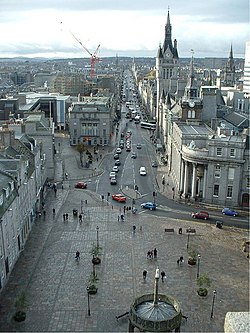 Union Street, Aberdeen City Centre | |
| Location | |
| Grid reference: | NJ925065 |
| Location: | 57°9’9"N, 2°6’36"W |
| Data | |
| Population: | 184,788 |
| Post town: | Aberdeen |
| Postcode: | AB10-AB13 (part), AB15, AB16, AB22-AB25 |
| Dialling code: | 01224 |
| Local Government | |
| Council: | City of Aberdeen |
| Parliamentary constituency: |
Aberdeen North Aberdeen South |
| Website: | aberdeencity.gov.uk |
Aberdeen is the county town of Aberdeenshire and Scotland's third most populous city. It is a major centre of the North Sea oil industry.
The city's nicknames include the Granite City, the Grey City and the Silver City with the Golden Sands. During the mid-18th to mid-20th centuries, Aberdeen's buildings incorporated locally quarried grey granite, whose mica deposits sparkle like silver.[1] The city has a long, sandy coastline. Since the discovery of North Sea oil in the 1970s, other nicknames have been the Oil Capital of Europe or the Energy Capital of Europe.[2]
In 1319, Aberdeen received Royal Burgh status from Robert the Bruce, transforming the city economically. The city has two universities, the University of Aberdeen was founded in 1495, which makes it one of the oldest in Britain. The Robert Gordon University was awarded university status in 1992 too. The traditional industries of fishing, paper-making, shipbuilding, and textiles have been overtaken by the oil industry and Aberdeen's seaport. In consequence, Aberdeen has become a major world centre for engineering expertise.
Aberdeen Heliport, supporting the offshore oil rigs, is one of the busiest commercial heliports in the world[3] and the seaport is the largest in the north-east of Scotland.[4]
Aberdeen has won the Britain in Bloom competition a record-breaking ten times,[5] and hosts the Aberdeen International Youth Festival, a major international event which attracts up to 1000 of the most talented young performing arts companies.
History

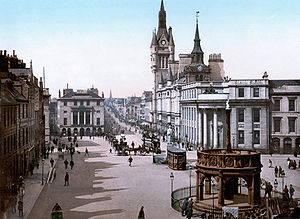
The area around Aberdeen has been settled since at least 8,000 years ago,[6] when prehistoric villages lay around the mouths of the rivers Dee and Don.
The city began as two separate burghs: Old Aberdeen at the mouth of the river Don; and New Aberdeen, a fishing and trading settlement, where the Denburn waterway entered the river Dee estuary. The earliest charter was granted by William I in 1179 and confirmed the corporate rights granted by David I.
In 1319, the Great Charter of Robert the Bruce transformed Aberdeen into a property-owning and financially independent community. Granted with it was the nearby Forest of Stocket, whose income formed the basis for the city's Common Good Fund, which still benefits Aberdonians.[7][8]
During the Wars of Scottish Independence, Aberdeen was under English rule, so Robert the Bruce laid siege to Aberdeen Castle before destroying it in 1308 followed by the massacring of the English garrison and the retaking of Aberdeen. The city was burned by King Edward III of England in 1336, but was rebuilt and extended, and called New Aberdeen. The city was strongly fortified to prevent attacks by neighbouring lords, but the gates were removed by 1770.
During the Wars of the Three Kingdoms of 1644-1647, the city was impartially plundered by both sides. In 1644, it was taken and ransacked by Royalist troops after the Battle of Aberdeen.[9] In 1647 an outbreak of bubonic plague killed a quarter of the population.
In the eighteenth century, a new Town Hall was built and the first social services appeared with the Aberdeen Royal Infirmary at Woolmanhill in 1742 and the Lunatic Asylum in 1779. The council began major road improvements at the end of the century with the main thoroughfares of George Street, King Street and Union Street all completed at the start of the next century.
A century later, the increasing economic importance of Aberdeen and the development of the shipbuilding and fishing industries led to the existing harbour with Victoria Dock, the South Breakwater, and the extension to the North Pier. The expensive infrastructure programme had repercussions, and in 1817 the city was bankrupt. However, a recovery was made in the general prosperity which followed the Napoleonic Wars. Gas street lighting arrived in 1824 and an enhanced water supply appeared in 1830 when water was pumped from the Dee to a reservoir in Union Place. An underground sewer system replaced open sewers in 1865.[8]
The city was first incorporated in 1891. Although Old Aberdeen still has a separate charter and history, it and New Aberdeen are no longer truly distinct, the city having expanded to incorporate both towns and neighbouring suburbs, including the Royal Burgh of Torry to the south of the River Dee in Kincardineshire.
Names of the City
Old Aberdeen is the approximate location of Aberdon the first settlement of Aberdeen; this literally means "the mouth of the Don" in relation to the local river. The modern name Aberdeen literally means between the Dee (the other local river) and Don. The prefix; Aber- means "mouth" or "confluence" in relation to the rivers.[10]
Gaelic scholars believe the name came from the prefix Aber- and da-aevi (variation;Da-abhuin, Da-awin) - which means "the mouth of two rivers". In Gaelic the name is Obar Dheathain (variation; Obairreadhain) and in Latin, the Romans referred to it as Devana. Mediæval (or ecclesiastical) Latin has it as Aberdonia.
Geography
On the coast, Aberdeen has a long sand beach between the two rivers, the Dee and the Don, which turns into high sand dunes north of the Don stretching as far as Fraserburgh. To the south of the Dee are steep rocky cliff faces with only minor pebble and shingle beaches in deep inlets. A number of granite outcrops along the south coast have been quarried in the past, making for spectacular scenery and good rock-climbing.
The modern city's urban area extends to include the former burghs of Old Aberdeen, New Aberdeen, Woodside and the Royal Burgh of Torry to the south of River Dee in Kincardineshire. The city is built on many hills, with the original beginnings of the city growing from Castle Hill, St Catherine's Hill and Windmill Hill.[11]
Climate
Aberdeen is far milder than one might expect for its northern location.
During the winter, especially throughout December, the length of the day is very short, averaging 6 hours and 40 minutes between sunrise and sunset at the Winter Solstice. As winter progresses, the length of the day grows fairly quickly, to 8 hours and 20 minutes by the end of January. As summer begins, the days will be around 18 hours long, having 17 hours and 57 minutes between sunrise and sunset, with Nautical Twilight lasting the entire night. Temperatures at this time of year will be around 17 °C during the day.
People
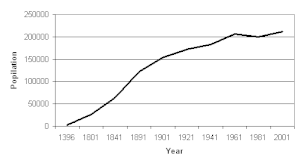
In 1396 the population was about 3,000. By 1801 it had become 26,992; (1901) 153,503; (1941) 182,467.[13] In 2001 the UK census records the Aberdeen City Council area's population at 212,125,[14] but the Aberdeen locality's population at 184,788.[15] Data from the Aberdeen specific locality of the 2001 UK census shows that the demographics include a median male age of 35 and female age of 38, which are younger than Scotland's average and a 49% to 51% male-to-female ratio.[14]
The census showed that there are fewer young people in Aberdeen, with 16.4% under 16, opposed to the national average of 19.2%.[16] Ethnically, 15.7% were born outside of Scotland, higher than the national average of 12.9%. Of this population 8.4% were born in England.[16] 3% of Aberdonians stated to be from an ethnic minority (non-white) in the 2001 census, with 0.7% from the Indian-subcontinent and 0.6% Asian; in comparison, Scotland's overall population of non-white origin is 2%. This is a lower percentage than any of Scotland's other three main cities, Glasgow, Edinburgh, and Dundee.[16] The most multicultural part of the city is George Street, which has many ethnic restaurants, supermarkets and hairdressers.
In the household, there were 97,013 individual dwellings recorded in the city of which 61% were privately owned, 9% privately rented and 23% rented from the council. The most popular type of dwellings are apartments which compromise 49% of residences followed by semi-detached at just below 22%.[17] The median income of a household in the city is £16,813 (the mean income is £20,292)[18] (2005) which places approximately 18% households in the city below the poverty line (defined as 60% of the mean income). Conversely, an Aberdeen postcode has the second highest number of millionaires of any postcode in the UK.[19]
Churches
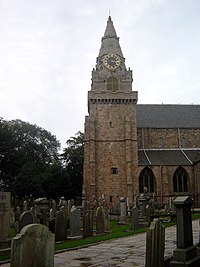
The city has many churches, of which the most noteworthy include:
- The Kirk of St Nicholas: in the Middle Ages this was the only burgh kirk and one of Scotland's largest parish churches. Like a number of other churches, it was divided after the Reformation, in this case into the East and West churches.
- St Machar's Cathedral: founded twenty years after David I (1124–53) transferred the pre-Reformation Diocese from Mortlach in Banffshire to Old Aberdeen in 1137. With the exception of the episcopate of William Elphinstone (1484–1511), building progressed slowly. Gavin Dunbar, who followed him in 1518, completed the structure by adding the two western spires and the southern transept.
- St Andrew's Cathedral: The Episcopal Church of Scotland's Cathedral, built in 1817 as Archibald Simpson's first commission. It consecrated the first bishop of the Episcopal Church in the United States of America.
- St Mary's Cathedral: a Roman Catholic cathedral in Gothic style, erected in 1859.
- The Salvation Army citadel dominates the east end of Union Street.
- a Unitarian Church, established in 1833, stands in Skene Terrace, near Union Street.
Aberdeen also has a Quaker meetinghouse on Crown Street, the only purpose built Quaker House in Scotland that is still in use today, an Orthodox Jewish Synagogue, established in 1945, an Islamic Mosque in Old Aberdeen and two Mormon meetinghouses.
Economy
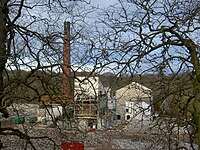
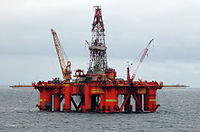
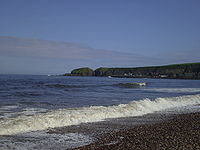
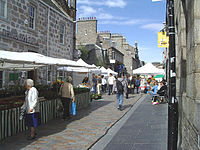
Traditionally, Aberdeen was home to fishing, textile mills, shipbuilding and paper making. These industries have been largely replaced. High technology developments in the electronics design and development industry, research in agriculture and fishing and the oil industry, which has been largely responsible for Aberdeen's economic boom in the last three decades, are now major parts of Aberdeen's economy.
Until the 1970s, most of Aberdeen's leading industries dated from the eighteenth Century; mainly these were textiles, foundry work, shipbuilding and paper-making, the oldest industry in the city, with paper having been first made there in 1694. Paper-making has reduced in importance since the closures of Donside Paper Mill in 2001 and the Davidson Mill in 2005 leaving the Stoneywood Paper Mill with a workforce of approximately 500. Textile production ended in 2004 when Richards of Aberdeen closed.
Grey granite was quarried at Rubislaw quarry for more than 300 years, and used for paving setts, kerb and building stones, and monumental and other ornamental pieces. Aberdeen granite was used to build the terraces of the Houses of Parliament and Waterloo Bridge in London. Quarrying finally ceased in 1971.
Fishing was once the predominant industry, but was surpassed by deep-sea fisheries, which derived a great impetus from improved technologies throughout the twentieth Century. Catches have fallen due to overfishing and the use of the harbour by oil support vessels,[20] and so although still an important fishing port it is now eclipsed by the more northerly ports of Peterhead and Fraserburgh. The Fisheries Research Services have their headquarters in Aberdeen, and there is a marine research lab in Torry.
Aberdeen is well regarded for the agricultural and soil research carried out at The Macaulay Institute, which has close links to the city's two universities. The Rowett Research Institute is a world-renowned research centre for studies into food and nutrition located in Aberdeen. It has produced three Nobel laureates and there is a high concentration of life scientists working in the city.[21][22]
There is also a dynamic and fast growing electronics design and development industry.
With the discovery of significant oil deposits in the North Sea during the late twentieth century, Aberdeen became the centre of Europe's petroleum industry. With the second largest heliport in the world and an important service ship harbour port serving oil rigs off-shore, Aberdeen is often called the Oil Capital of Europe.[23]
There is now a concerted effort to transform Aberdeen's reputation as the Oil Capital of Europe into the Energy Capital of Europe as oil supplies may start to dwindle in coming years, and there is considerable interest in the development of new energy sources; and technology transfer from oil into renewable energy and other industries is under way. The "Energetica" initiative led by Scottish Enterprise has been designed to accelerate this process.[24]
The city ranks third in Scotland for shopping. The traditional shopping streets are Union Street and George Street, now complemented by shopping centres, notably the St Nicholas & Bon Accord and The Mall. A new retail £190 million development, Union Square, reached completion in late September/early October 2009. Major retail parks away from the city centre include the Berryden Retail Park, the Kittybrewster Retail Park and the Beach Boulevard Retail Park.
Landmarks
Aberdeen's architecture is known for its principal use during the Victorian era of granite, which has led to its local nickname of the Granite City or more romantically the less commonly used name the Silver City, since the Mica in the stone sparkles in the sun. The hard grey stone is one of the most durable materials available and helps to explain why the city's buildings look brand-new when they have been newly cleaned and the cement has been pointed. Unlike other Scottish cities where sandstone has been used, the buildings are not weathering and need very little structural maintenance on their masonry.

Amongst the notable buildings in the city's main street, Union Street, are the Town and County Bank, the Music Hall, the Trinity Hall of the incorporated trades (originating between 1398 and 1527), now a shopping mall; the former office of the Northern Assurance Company, and the National Bank of Scotland. In Castle Street, a continuation eastwards of Union Street, is the new Town House, a very prominent landmark in Aberdeen, built between 1868 and 1873 to a design by Peddie and Kinnear.[25]
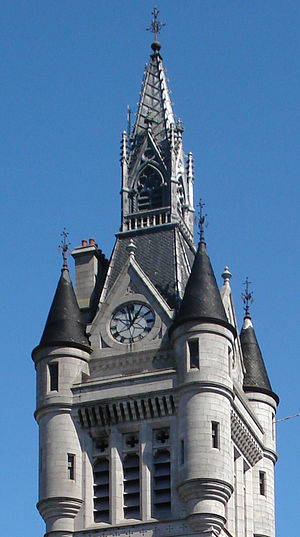
Alexander Marshall Mackenzie's extension to Marischal College on Broad Street, opened by King Edward VII in 1906, created the second largest granite building in the world (after the Escorial, Madrid).[26]
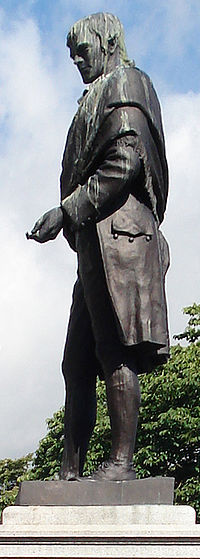
In addition to the many fine landmark buildings, Aberdeen has many prominent public statues, two of the most notable being William Wallace at the junction between Union Terrace and Rosemount Viaduct, and Robert Burns on Union Terrace, above Union Terrace Gardens.
Transport
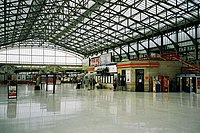
Aberdeen Airport (ABZ), at Dyce in the north of the city, serves a number of domestic and international destinations including France, the Netherlands, Spain, Belgium, Austria, Ireland and Scandinavian countries. The heliport which serves the oil industry and rescue services is one of the busiest commercial heliports in the world.[3]
Aberdeen railway station is on the main rail network and has frequent direct trains to major cities such as Edinburgh, Glasgow and London, including the overnight Caledonian Sleeper train. The station is currently being updated to bring it into the modern age. In 2007 additions were made and a new ticket office was built in the building.
Until 2007, a 1950s-style concrete bus station at Guild Street served out-of-the-city locations; it has since transferred to a new and well-presented bus station just 100 yards to the east off Market Street as part of the Union Square development.
There are six major roads in and out of the city. The A90 is the main arterial route into the city from the north and south, linking Aberdeen to Edinburgh, Dundee, Brechin and Perth in the south and Ellon, Peterhead and Fraserburgh in the north. The A96 links to Elgin and Inverness and the north west. The A93 is the main route to the west, heading towards Royal Deeside and the Cairngorms. After Braemar, it turns south, providing an alternative tourist route to Perth. The A944 also heads west, through Westhill and on to Alford. The A92 was the original southerly road to Aberdeen prior to the building of the A90, and is now used as a tourist route, connecting the towns of Montrose and Arbroath and on the east coast. The A947 exits the city at Dyce and goes on to Newmachar, Oldmeldrum and Turriff finally ending at Banff and Macduff.
Aberdeen Harbour is important as the largest in the north of Scotland and as a ferry route to Orkney and Shetland. Established in 1136, it has been referred to as the oldest business in Britain.[27]
Aberdeen is connected to the UK National Cycle Network, and has a track to the south connecting to cities such as Dundee and Edinburgh and one to the north that forks about 10 miles from the city into two different tracks heading to Inverness and Fraserburgh respectively. Two particularly popular footpaths along old railway tracks are the Deeside Way to Banchory in Kincardineshire (which will eventually connect to Ballater) and the Formartine and Buchan Way to Ellon, both used by a mixture of cyclists, walkers and occasionally horses. Four park-and-ride sites serve the city: Stonehaven and Ellon (approx 12–17 miles out from the city centre) and Kingswells and Bridge of Don (approx 3–4 miles out).
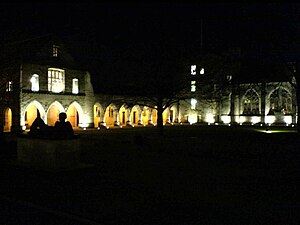
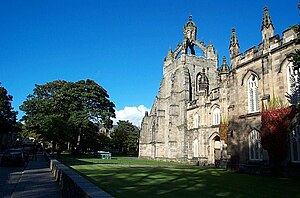
Universities and colleges
Aberdeen has two universities, the University of Aberdeen, a venerable institution, and the Robert Gordon University.
The University of Aberdeen began as King's College, Aberdeen, which was founded in 1495 by William Elphinstone (1431–1514), Bishop of Aberdeen and Chancellor of Scotland. Marischal College, a separate institution, was founded in "New" Aberdeen by George Keith, fifth Earl Marischal of Scotland in 1593. These institutions were amalgamated to form the present University of Aberdeen in 1860. The university is the fifth oldest in the English speaking world.[28]
Robert Gordon's College (originally Robert Gordon's Hospital) was founded in 1729 by the merchant Robert Gordon, grandson of the map maker Robert Gordon of Straloch, and was further endowed in 1816 by Alexander Simpson of Collyhill. Originally devoted to the instruction and maintenance of the sons of poor burgesses of guild and trade in the city, it was reorganised in 1881 as a day and night school for secondary and technical education. In 1903, the vocational education component of the college was designated a Central Institution and was renamed the Robert Gordon Institute of Technology in 1965. In 1992, university status was gained and it became the Robert Gordon University.
Aberdeen is also home to two artistic schools: Gray's School of Art, founded in 1886, which is one of the oldest established colleges of art in the UK, and is now incorporated into Robert Gordon University; and The Scott Sutherland School of Architecture and The Built Environment, which is situated on the Garthdee Campus of the Robert Gordon University, next to Gray's School of Art.
Aberdeen College has several campuses in the city and offers a wide variety of part-time and full-time courses leading to several different qualifications in science. It is the largest further education institution in Scotland.[29]
The Scottish Agricultural College is based just outside Aberdeen, on the Craibstone Estate. This is situated beside the roundabout for Aberdeen Airport on the A96. The college provides three services - Learning, Research and Consultancy. The college features many land based courses such as Agriculture, Countryside Management, Sustainable Environmental Management and Rural Business Management. There are a variety of courses from diplomas through to masters degrees.
Culture
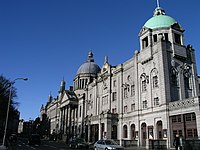
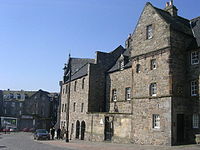
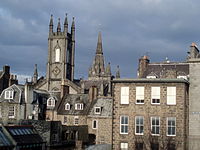
The city has a wide range of cultural activities, amenities and museums. The city is regularly visited by Scotland's National Arts Companies. The Aberdeen Art Gallery houses a collection of Impressionist, Victorian, Scottish and twentieth Century British paintings as well as collections of silver and glass. It also includes The Alexander Macdonald Bequest, a collection of late nineteenth century works donated by the museum's first benefactor and a constantly changing collection of contemporary work and regular visiting exhibitions.[30]
Museums and galleries
The Aberdeen Maritime Museum, located in Shiprow, tells the story of Aberdeen's links with the sea from the days of sail and clipper ships to the latest oil and gas exploration technology. It includes an 8.5 m (28 feet) high model of the Murchison oil production platform and a nineteenth-century assembly taken from Rattray Head lighthouse.[31]
Provost Ross' House is the second oldest dwelling house in the city. It was built in 1593 and became the residence of Provost John Ross of Arnage in 1702. The house retains some original mediæval features, including a kitchen, fireplaces and beam-and-board ceilings.[32] The Gordon Highlanders Museum tells the story of one of Scotland's best known regiments.[33]
Marischal Museum holds the principal collections of the University of Aberdeen, comprising some 80,000 items in the areas of fine art, Scottish history and archaeology, and European, Mediterranean & Near Eastern archaeology. The permanent displays and reference collections are augmented by regular temporary exhibitions.[34]
Performing arts
Aberdeen is home to a host of events and festivals including the Aberdeen International Youth Festival (the world's largest arts festival for young performers), Aberdeen Jazz Festival, Rootin' Aboot (folk and roots music event based at the Lemon Tree), Triptych, and the University of Aberdeen's literature festival Word.
The Aberdeen Student Show, performed annually without interruption since 1921, under the auspices of the Aberdeen Students' Charities Campaign, is the longest-running of its kind in the United Kingdom. It is written, produced and performed by students and graduates of Aberdeen's institutes of tertiary education, and since 1929 - other than on a handful of occasions - has been staged at His Majesty's Theatre. The Student Show traditionally combines comedy and music, inspired by the North-East's Doric dialect and humour.
Music and film
Aberdeen's music scene includes a variety of live music venues including pubs, clubs, and church choirs. The bars ofBelmont Street are particularly known for featuring live music. Cèilidhs are also common in the city's halls. The many popular venues include The Moorings, The Lemon Tree, Drummonds, Moshulu (now owned by Barfly), Snafu, The Tunnels, the Aberdeen Exhibition and Conference Centre, and Aberdeen Music Hall.
Notable Aberdonian musicians include Evelyn Glennie, Ronnie McLeod (trumpeter and bandleader), cult band Pallas, Richard Head Band (Rock) and Abba Elite (Tribute band). Contemporary composers John McLeod and Martin Dalby also hail from Aberdeen.
The first and only Doric speaking feature film by Stirton Productions and Canny Films was released in 2008. 'One Day Removals' starring Patrick Wight and Scott Ironside tells the tale of two unlucky removal men whose day goes from bad to worse. Filmed on location in Aberdeenshire for a budget of £60,000, it is a black comedy/adult drama.
Cultural cinema, educational work and local film events are provided by The Belmont Picturehouse on Belmont Street, Peacock Visual Arts and The Foyer.
Open spaces
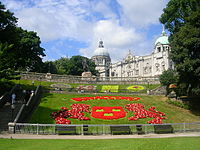
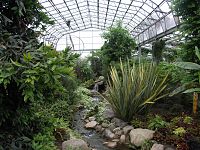
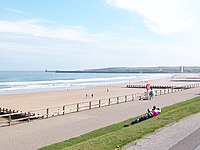
Aberdeen has long been famous for its 45[5] outstanding parks and gardens, and citywide floral displays which include two million roses, eleven million daffodils and three million crocuses. The city has won the Royal Horticultural Society's Britain in Bloom 'Best City' award ten times,[5] the overall Scotland in Bloom competition twenty times[5] and the large city category every year since 1968.[5] At one point after winning a period of nine years straight, Aberdeen was banned from the Britain in Bloom competition to give another city a chance.[35] The city won the 2006 Scotland in Bloom "Best City" award along with the International Cities in Bloom award. The suburb of Dyce also won the Small Towns award.[36][37]
Duthie Park opened in 1899 on the north bank of the River Dee. It was named after and gifted to the city by Miss Elizabeth Crombie Duthie of Ruthrieston in 1881. It has extensive gardens, a rose hill, boating pond, bandstand, and play area as well as Europe's second largest enclosed gardens the David Welch Winter Gardens. Hazlehead Park is large and forested, located on the outskirts of the city, it is popular with walkers in the forests, sports enthusiasts, naturalists and picnickers. There are football pitches, two golf courses, a pitch and putt course and a horse riding school.
Aberdeen's success in the Britain in Bloom competitions is often attributed to Johnston Gardens, a small park of one hectare in the west end of the city containing many different flowers and plants which have been renowned for their beauty. The garden was in 2002, named the best garden in the British Islands.[5]
Seaton Park, formerly the grounds of a private house, is on the edge of the grounds of St Machar's Cathedral. The Cathedral Walk is maintained in a formal style with a great variety of plants providing a popular display. The park includes several other areas with contrasting styles to this.
Union Terrace Gardens opened in 1879 and is situated in the centre of the city. It covers 2 and half acres in the centre of Aberdeen bordered on three sides by Union Street, Union Terrace and Rosemount Viaduct. The park forms a natural amphitheatre located in the Denburn Valley and is an oasis of peace and calm in the city centre. A recent proposal to build a three storey concrete and steel superstructure in place of the gardens, part of which will provide a commercial concourse, has proved highly controversial.
Situated next to each other, Victoria Park and Westburn Park cover 26 acres between them. Victoria Park opened in 1871. There is a conservatory used as a seating area and a fountain made of fourteen different granites, presented to the people by the granite polishers and master builders of Aberdeen. Opposite to the north is Westburn Park opened in 1901. With large grass pitches it is widely used for field sports. There is large tennis centre with indoor and outdoor courts, a children's cycle track, play area and a grass boules lawn.
Dialect
Listen to recordings of a speaker of Scots from Aberdeen The local dialect of Lowland Scots is often known as the Doric, and is spoken not just in the city, but across the north-east of Scotland. It differs somewhat from other Scots dialects most noticeable are the pronunciation f for what is normally written wh and ee for what in standard English would usually be written oo (Scots ui). Every year the annual Doric Festival[38] takes place in Aberdeenshire to celebrate the history of the north-east's language. As with all Scots dialects in urban areas, it is not spoken as widely as it used to be in Aberdeen.
Media
Aberdeen is home to Scotland's oldest newspaper, the Press and Journal, first published in 1747. The Press and Journal and its sister paper the Evening Express are printed six days a week by Aberdeen Journals. There are two free newspapers: Aberdeen Record PM and Aberdeen Citizen.
The BBC has a network studio production base in Aberdeen's Beechgrove area, and BBC Aberdeen produces The Beechgrove Potting Shed for radio and Tern Television produces the Beechgrove Garden television programme.[39] The city is also home to STV North (formerly Grampian Television), which produces the nightly regional news programme, STV News at Six, as well as local commercials. The station, based at Craigshaw Business Park in Tullos, was based at larger studios in Queens Cross from September 1961 until June 2003.
There are three commercial radio stations operating within the city, Northsound Radio, which runs Northsound One and Northsound Two, and independent station Original 106. Other radio stations include NECR FM (North-East Community Radio FM) DAB station,[40] and shmu FM[41] managed by Station House Media Unit[42] which supports community members to run Aberdeen's first (and only) full-time community radio station, broadcasting on 99.8 MHz FM.
Sport
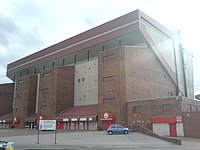
Football
The Scottish Premier League football club, Aberdeen F.C. play at Pittodrie. The club won the European Cup Winners Cup and the European Super Cup in 1983 and the Scottish Premier League Championship four times (1955, 1980, 1984 and 1985), the Scottish Cup seven times (1947, 1970, 1982, 1983, 1984, 1986 and 1990). Under Sir Alex Ferguson, they were a major force in British football during the 1980s.
The other senior team is Cove Rangers F.C. of the Highland Football League (HFL), who play at Allan Park in the suburb of Cove Bay, although they will be moving to Calder Park once it is built to boost their chances of getting into the Scottish Football League.[43] Cove won the HFL championship in 2001 and 2008.
There was also a historic senior team Bon Accord F.C. who no longer play. Local junior teams include Banks O' Dee F.C., Culter F.C., F.C. Stoneywood, Glentanar F.C. and Hermes F.C.
Granite City Stormers, a gay football club, was founded in Aberdeen in 2008.[44]
Rugby Union
Aberdeen hosted Caledonia Reds a Scottish rugby franchise, before they merged with the Glasgow Warriors in 1998. The city is also home to the Premiership Division Two rugby club Aberdeen GSFP RFC who play at Rubislaw Playing Fields, and Aberdeenshire RFC which was founded in 1875 and runs Junior, Senior Mens, Senior Ladies and Touch sections from the Woodside Sports Complex[45] and also Aberdeen Wanderers RFC. Former Wanderers' player Jason White was captain of the Scotland national rugby union team.
In 2005 the President of the SRU said it was hoped eventually to establish a professional team in Aberdeen.[46] In November 2008 the city hosted a rugby international at Pittodrie between Scotland and Canada, with Scotland winning 41-0.[47]
Golf
The Royal Aberdeen Golf Club, founded in 1780 and the oldest golf club in Aberdeen, hosted the Senior British Open in 2005.[48] The club has a second course, and there are public golf courses at Auchmill, Balnagask, Hazlehead and King's Links.[49] The 1999 winner of the The Open Championship, Paul Lawrie, hails from the city.
There are new courses planned for the area, including world class facilities with major financial backing, the city and shire are set to become a hotbed for golf tourism.
Donald Trump is building his new state of the art golf course out beside Balmedie.
Swimming
The City of Aberdeen Swim Team (COAST) is based in Northfield swimming pool and has been in operation since 1996. The team comprises several smaller swimming clubs, and has enjoyed success throughout Scotland and in international competitions. Three of the team's swimmers qualified for the 2006 Commonwealth Games.[50]
Rowing
Rowing exists on the River Dee, south of the town centre. Four clubs are located on the banks: Aberdeen Boat Club (ABC), Aberdeen Schools Rowing Association (ASRA), Aberdeen University Boat Club (AUBC) and Robert Gordon University Boat Club (RGUBC).
Cricket
Aberdeen boasts a large cricket community with 4 local leagues operating that comprise of a total of 25 clubs fielding 36 teams. The city has two national league sides, Aberdeenshire, and Stoneywood-Dyce. Local 'Grades'[51] cricket has been played in Aberdeen since 1884. Aberdeenshire recently became the 2009 Scottish National Premier League and Scottish Cup Champions [52]
Floorball
Aberdeen Oilers Floorball Club was founded in 2007. The club initially attracted a range of experienced Scandinavian and other European players who were studying in Aberdeen. Since their formation, Aberdeen Oilers have played in the British Floorball Northern League and went on to win the league in the 2008/09 season. The club played a major role in setting up a ladies league in Scotland. The Oiler's ladies team ended up 2nd in the first ladies league season (2008/09).[53]
Other sports
The city council operates public tennis courts in various parks including an indoor tennis centre at Westburn Park. The Beach Leisure Centre is home to a climbing wall, gymnasium and a swimming pool. There are numerous swimming pools dotted around the city notably the largest, the Bon-Accord Baths which closed down in 2006. Aberdeen has numerous skateparks dotted around the city in Torry, Westburn Park and Transition Extreme. Transition Extreme is an indoor skatepark built in 2007 it was designed by Aberdeen skate legend Andy Dobson. Aberdeen City council also have an Outdoor Education service which is now known as adventure aberdeen, that provides abseiling, surfing, white water rafting, gorge walking, kayaking and open canoeing, mountaineering, sailing, mountain biking and rock climbing. They inspire learning through adventure and have many programs for children and adults.[54]
Heraldry
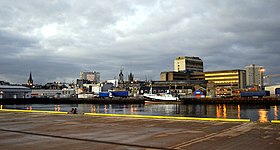
Symbols of the city typically show three castles, such as in the case of the flag and coat of arms. The image has been around since the time of Robert the Bruce and represents the buildings that stood on the three hills of Aberdeen; Aberdeen Castle on Castle Hill (today's Castlegate); an unknown building on Windmill Hill and a church on St Catherine's Hill (now levelled).[55]
"Bon Accord" is the motto of the city and is French literally for "Good Agreement". Legend tells that its use dates from the fourteenth century password used by Robert the Bruce during the Wars of Scottish Independence, when he and his men laid siege to Aberdeen Castle before destroying it in 1308.[7]
The leopard has traditionally been associated with the city and its emblem can be seen on the city crest. The local magazine is called the "Leopard" and, when Union Bridge was constructed in the nineteenth century, small statues of the creature in a sitting position were cast and placed on top of the railing posts.
The city's toast is "Happy to meet, sorry to part, happy to meet again"; this has been commonly misinterpreted as the translation of Bon Accord.[56]
Aberdeen in literature and popular fiction
- Stuart MacBride's crime novels, Cold Granite, Dying Light, Broken Skin, Flesh House, Blind Eye and Dark Blood (a series with main protagonist, DS Logan MacRae) are all set in Aberdeen. DS Logan MacRae is a Grampian Police officer and locations found in the books can be found in Aberdeen and the surrounding countryside.
- A large part of the plot of the World War II spy thriller Eye of the Needle takes place in wartime Aberdeen, from which a German spy is trying to escape to a submarine waiting offshore.
- Stewart Home's sex and literary obsessed contemporary novel 69 Things to Do with a Dead Princess is set in Aberdeen
- A portion of Ian Rankin's novel Black and Blue (1997) is set in Aberdeen.
- Sarah Jane Smith from the popular sci-fi show Doctor Who was accidentally returned to Aberdeen instead of her home in South Croydon by the fourth incarnation of the Doctor.
- The successful Channel 4 sitcom Peep Show makes occasional reference to Aberdeen, as the employer of one of the main characters has an office in Aberdeen. In one episode Mark Corrigan is desperate to be put on secondment to Aberdeen so as to spend some time with his love interest, Sophie, whilst in another episode, Mark's boss, Alan Johnston, announces that he is "just back from Aberdeen."
- The fictional character Groundskeeper Willie, a recurring character on the American TV show "The Simpsons" is heard cheering "Go Aberdeen" upon waking up from a dream in the episode titled 'Scuse Me While I Miss the Sky.
- Star Trek's chief engineer, Mr. Scott, in the episode "Wolf in the Fold", described himself as "an old Aberdeen pub crawler."
Outside links
- Aberdeen City Council
- Aberdeen at the Open Directory Project
- Aberdeen Facts
- A brief history of Aberdeen
- Undiscovered Scotland Aberdeen History
- Aberdeen Art Galleries and Museums
- Events Calendar for Aberdeen City and surrounding area
- Oil and the City Aberdeen's relationship with the oil industry.
- The Kiosque What's on guide to the city including listings and previews
- City of Aberdeen Swim Team (COAST)
- Entertainment guide of what to do in Aberdeen
- Aberdeen Search City portal, visitor guide and local search engine.
References
- ↑ "The Granite City". Aberdeen and Grampian Tourist Board. http://www.agtb.org/aberdeen-scotland.htm. Retrieved 2007-02-08.
- ↑ "About Aberdeen". University of Aberdeen. http://www.abdn.ac.uk/central/abdn/. Retrieved 2007-02-08.
- ↑ 3.0 3.1 "BAA Aberdeen Airport". http://www.aberdeenairport.com/portal/site/default/menuitem.25db388ed11fced74aafa810c02865a0. Retrieved 2007-07-31.
- ↑ "Architecture of Aberdeen, Scotland". Archived from the original on 2007-06-09. http://web.archive.org/web/20070609221650/http://uk.archiseek.com/scotland/aberdeen/index.html. Retrieved 2007-05-23.
- ↑ 5.0 5.1 5.2 5.3 5.4 5.5 "Floral Capital of Scotland". British Publishing. 2007-02-20. http://www.british-publishing.com/Pages/AberdeenOG/floral.html.
- ↑ "Welcome to Aberdeen". Aberdeen Accommodation Index. http://www.scottishaccommodationindex.com/aberdeenpics.htm. Retrieved 2007-02-19.
- ↑ 7.0 7.1 Keith, Alexander (1987). A Thousand Years of Aberdeen. Aberdeen University Press.
- ↑ 8.0 8.1 Fraser, W. Hamish (2000). Aberdeen, 1800 to 2000: A New History. Edinburgh: Tuckwell Press.
- ↑ Brown, Chris (2002). The Battle of Aberdeen 1644. Stroud, Gloucestershire: Tempus Publishing.
- ↑ Charnock, Richard Stephen. Local Etymology: A Derivative Dictionary of Geographical Names. Houlston and Wright.
- ↑ "Aberdeen City". The Gazetteer for Scotland. http://www.geo.ed.ac.uk/scotgaz/councils/councilfirst1.html. Retrieved 2007-02-20.
- ↑ "Data Documentation". http://www.visionofbritain.org.uk. Retrieved 2007-05-15.
- ↑ "Aberdeen Population". http://web.archive.org/web/20080120201443/http://www.visionofbritain.org.uk/data_cube_table_page.jsp?data_theme=T_POP&data_cube=N_TPop&u_id=10192985&c_id=10090283&add=N. Retrieved 2007-02-19.
- ↑ 14.0 14.1 "Comparative Population Profile: Aberdeen City Council Area, Scotland". http://www.scrol.gov.uk/scrol/browser/profile.jsp?profile=Population&mainArea=Aberdeen+City&mainLevel=CouncilArea. Retrieved 2007-02-21.
- ↑ "Comparative Population Profile: Aberdeen Locality, Scotland". http://www.scrol.gov.uk/scrol/browser/profile.jsp?profile=Population&mainArea=Aberdeen&mainLevel=Locality. Retrieved 2007-02-21.
- ↑ 16.0 16.1 16.2 Cite error: Invalid
<ref>tag; no text was provided for refs namedcitycensusreview - ↑ "Comparative Household Profile: Aberdeen City Council Area, Scotland". http://www.scrol.gov.uk/scrol/browser/profile.jsp?profile=Household&mainLevel=CouncilArea&mainArea=Aberdeen+City&mainText=&mainTextExplicitMatch=null&compLevel=CountryProfile&compArea=Scotland&compText=&compTextExplicitMatch=null. Retrieved 2007-02-21.
- ↑ Aberdeen City Council. "Low Income Households in Aberdeen". http://web.archive.org/web/20070927031848/http://www.aberdeencity.gov.uk/ACCI/nmsruntime/saveasdialog.asp?lID=1726&sID=332. Retrieved 2007-03-12.
- ↑ "Scottish homes market view 2008". The Times (London). 28 September 2008. http://property.timesonline.co.uk/tol/life_and_style/property/buying_and_selling/article4833999.ece.
- ↑ "Aberdeen Harbour: A History of Service". Aberdeen Harbour Board. http://www.aberdeen-harbour.co.uk/history.html. Retrieved 2007-02-18.
- ↑ "History and Background". Rowett Research Institute. http://www.rowett.ac.uk/institute/history.html. Retrieved 2007-02-01.
- ↑ "A Scientist's guide to Scotland". New Scientist. http://www.sciencejobs.com/insider/article.action?article.id=insider126&focusId=scotland. Retrieved 2007-02-08.
- ↑ "Aberdeen - Introduction to the city". Scottish Enterprise. http://www.talentscotland.com/view_item.aspx?item_id=912. Retrieved 2007-02-18.
- ↑ "A burst of energy in Europe's oil capital". BBC News Online. 12 November 2003. http://news.bbc.co.uk/1/hi/business/3236703.stm.
- ↑ "Overview of Town House". Geo.ed.ac.uk. http://www.geo.ed.ac.uk/scotgaz/features/featurefirst6629.html. Retrieved 2009-06-25.
- ↑ "Overview of Marischal College". Geo.ed.ac.uk. http://www.geo.ed.ac.uk/scotgaz/features/featurefirst1482.html. Retrieved 2009-06-25.
- ↑ "It's a fact: 50 things you may not have known about Aberdeen". Aberdeen Official Guide. http://www.british-publishing.com/Pages/AberdeenOG/fact.html. Retrieved 2007-02-15.
- ↑ Carter, Jennifer (1994). Crown and Gown: Illustrated History of the University of Aberdeen, 1495-1995. Aberdeen: Aberdeen University Press.
- ↑ Leading Scottish figures to be honoured by the University of Aberdeen, University of Aberdeen Media Release, 19 November 2004
- ↑ "Aberdeen Art Gallery". Aberdeen Art Galleries and Museums. http://www.aagm.co.uk/code/emuseum.asp?page=buildings_art_gallery. Retrieved 2007-02-18.
- ↑ "Aberdeen Maritime Museum". Aberdeen Art Galleries and Museums. http://www.aagm.co.uk/code/emuseum.asp?page=buildings_maritime_museum. Retrieved 2007-02-18.
- ↑ "Provost Ross' House". The Gazetteer for Scotland. http://www.geo.ed.ac.uk/scotgaz/features/featurefirst1498.html. Retrieved 2007-02-18.
- ↑ "The Gordon Highlanders Museum". Army Museums Ogilby Trust. http://www.armymuseums.org.uk/amot-search/default.asp?Category=Amot&Service=Museum-Display&reference=0000000037. Retrieved 2007-02-18.
- ↑ "Marischal Museum: Introduction". University of Aberdeen. http://www.abdn.ac.uk/historic/museum/. Retrieved 2007-02-18.
- ↑ Simpson, Maureen (2006-09-22). "We're top of Brit parade". Press and Journal. http://web.archive.org/web/20070929103259/http://www.rhs.org.uk/britaininbloom/scotland/aberdeen2006.asp.Template:Dead link
- ↑ "2006 winners". Royal Horticultural Society. Archived from the original on 2007-09-29. http://web.archive.org/web/20070929103259/http://www.rhs.org.uk/britaininbloom/scotland/aberdeen2006.asp. Retrieved 2007-02-08.
- ↑ "Aberdeen's blooming success goes worldwide". Press and Journal. 2006-12-28. http://www.pressandjournal.co.uk/displayNode.jsp?nodeId=149235&command=displayContent&sourceNode=149218&contentPK=16277782&moduleName=InternalSearch&formname=sidebarsearch.Template:Dead link
- ↑ "The Doric Festival". The Doric Festival. http://www.thedoricfestival.com. Retrieved 2009-06-25.
- ↑ "The Beechgrove Garden". Tern Television. http://www.beechgrove.co.uk/home/Default.asp.
- ↑ "Digital Radio Now, Station List". Archived from the original on 2007-10-26. http://web.archive.org/web/20071026031231/http://www.digitalradionow.com/statl.php.
- ↑ "Shmu community media productions". Shmufm.net. http://www.shmufm.net. Retrieved 2009-06-25.
- ↑ "Shmu community media productions". Shmu.org.uk. http://www.shmu.org.uk. Retrieved 2009-06-25.
- ↑ "Cove Rangers FC". Highland Football League. http://www.highlandfootballleague.com/clubs/showclub.php?id=4. Retrieved 2007-02-16.
- ↑ "Granite City Stormers FC". http://www.stormersfc.co.uk/aboutus.html. Retrieved 2010-05-25.
- ↑ "Aberdeenshire Rugby Football Club - The Community Club". Aberdeenshirerfc.org.uk. http://www.aberdeenshirerfc.org.uk/. Retrieved 2009-06-25.
- ↑ "BBC SPORT | Rugby Union | Scottish | Irvine wants an Aberdeen pro-team". BBC News. 2005-09-13. http://news.bbc.co.uk/sport1/hi/rugby_union/scottish/4241554.stm. Retrieved 2009-06-25.
- ↑ [1]
- ↑ "Golf event to swing into Aberdeen". British Broadcasting Corporation. 2006-05-08. http://news.bbc.co.uk/1/hi/scotland/north_east/4750395.stm.
- ↑ "Aberdeen City Golf Homepage". Aberdeen City Council. http://www.aberdeencity.gov.uk/ACCI/web/site/Sports/spr_GolfHomepage.asp?menuid=m101603. Retrieved 2007-02-16.
- ↑ "City of Aberdeen Swim Team". http://www.coastswimming.org.uk/. Retrieved 2009-04-16.
- ↑ "Aberdeen Grades Association". http://acagrades.org.uk/.
- ↑ "CricketScotland". http://cricketscotland.com/ScottishCupFinal09.
- ↑ "Aberdeen Oilers Floorball Club". http://www.aberdeenfloorball.org.uk/.
- ↑ http://www.aberdeencity.gov.uk/adventureaberdeen
- ↑ Gazetter for Scotland. "Aberdeen City". http://www.geo.ed.ac.uk/scotgaz/councils/councilfirst1.html. Retrieved 2007-05-15.
- ↑ "Aberdeen Official Guide". Aberdeen City Council. http://www.british-publishing.com/Pages/AberdeenOG/introducing.html. Retrieved 2007-02-17.
Further reading
- Brown, Chris (2002). The Battle of Aberdeen 1644. Tempus Publishing.
- Carter, Jennifer (1994). Crown and Gown: Illustrated History of the University of Aberdeen, 1495-1995. Aberdeen University Press. ISBN 1857522400.
- Fraser, W. Hamish (2000). Aberdeen, 1800 to 2000: A New History. Tuckwell Press. ISBN 1862321752.
- Keith, Alexander (1987). A Thousand Years of Aberdeen. Aberdeen University Press. ISBN 0900015292.
- Peter Innes - Fit Like New York? An Irreverent History of Rock and Pop Music in Aberdeen and North East Scotland. Publisher The Evening Express, 1998
| Cities in the United Kingdom |
|---|
|
Aberdeen • Armagh • Bangor (Caernarfonshire) • Bangor (County Down) • Bath • Belfast • Birmingham • Bradford • Brighton and Hove • Bristol • Cambridge • Canterbury • Cardiff • Carlisle • Chelmsford • Chester • Chichester • Colchester • Coventry • Derby • Doncaster • Dundee • Dunfermline • Durham • Ely • Edinburgh • Exeter • Glasgow • Gloucester • Hereford • Inverness • Kingston upon Hull • Lancaster • Leeds • Leicester • Lichfield • Lincoln • Lisburn • Liverpool • City of London • Londonderry • Manchester • Milton Keynes • Newcastle upon Tyne • Newport • Newry • Norwich • Nottingham • Oxford • Perth • Peterborough • Plymouth • Portsmouth • Preston • Ripon • Rochester • Salford • Salisbury • Sheffield • Southampton • St Albans • St Asaph • St David's • Southend-on-Sea • Stirling • Stoke-on-Trent • Sunderland • Swansea • Truro • Wakefield • Wells • Westminster • Winchester • Wolverhampton • Worcester • Wrexham • York |